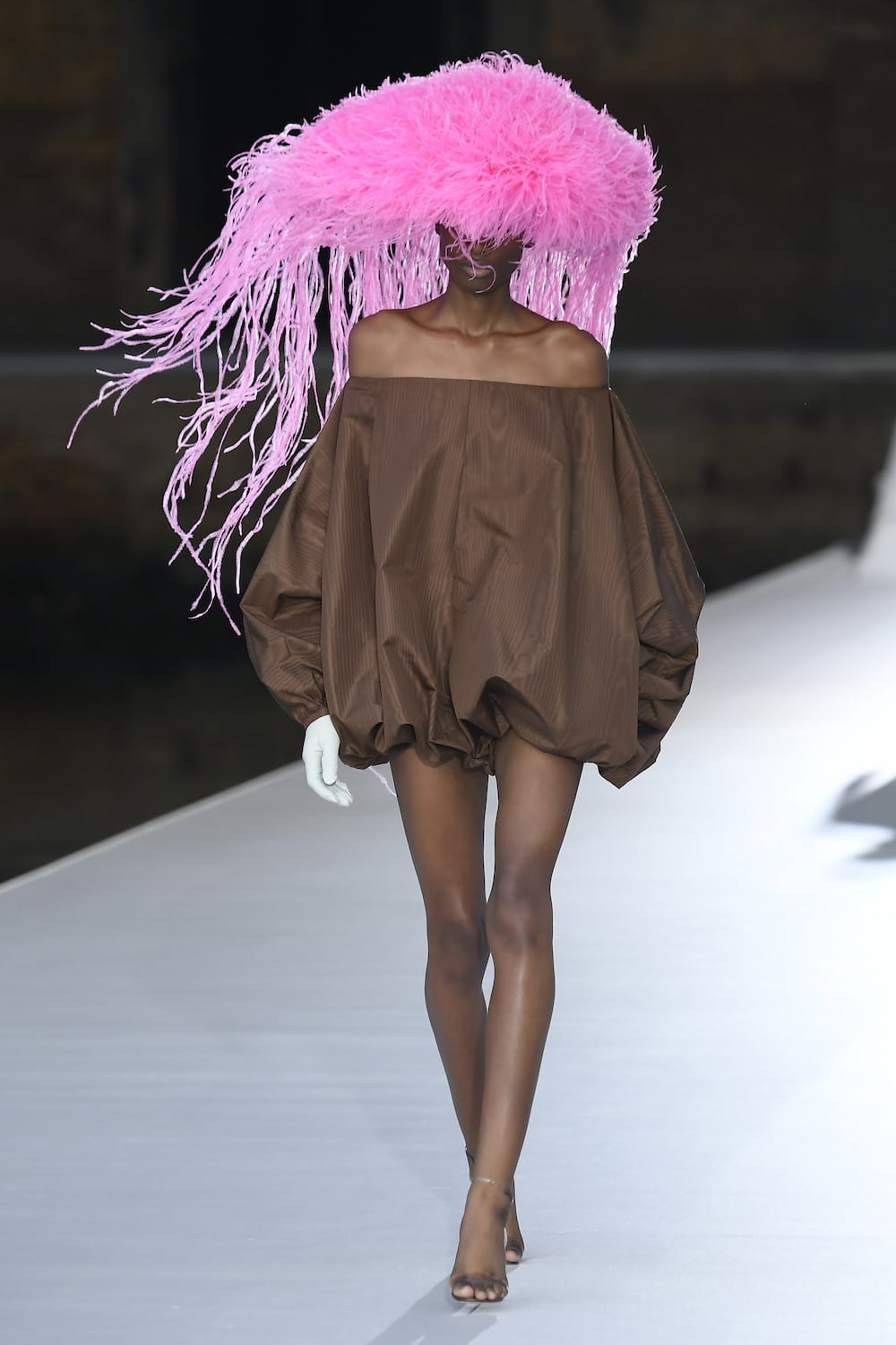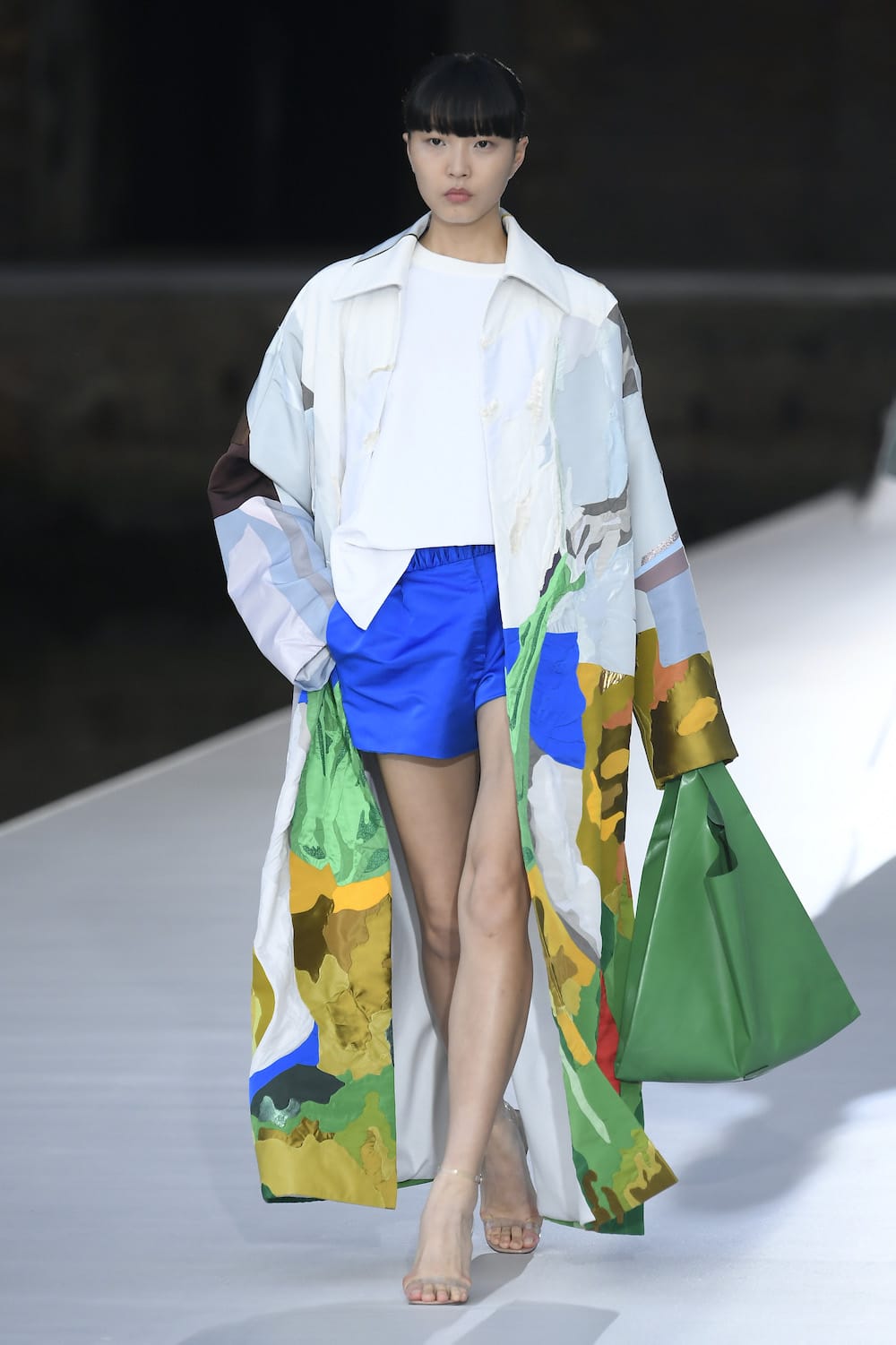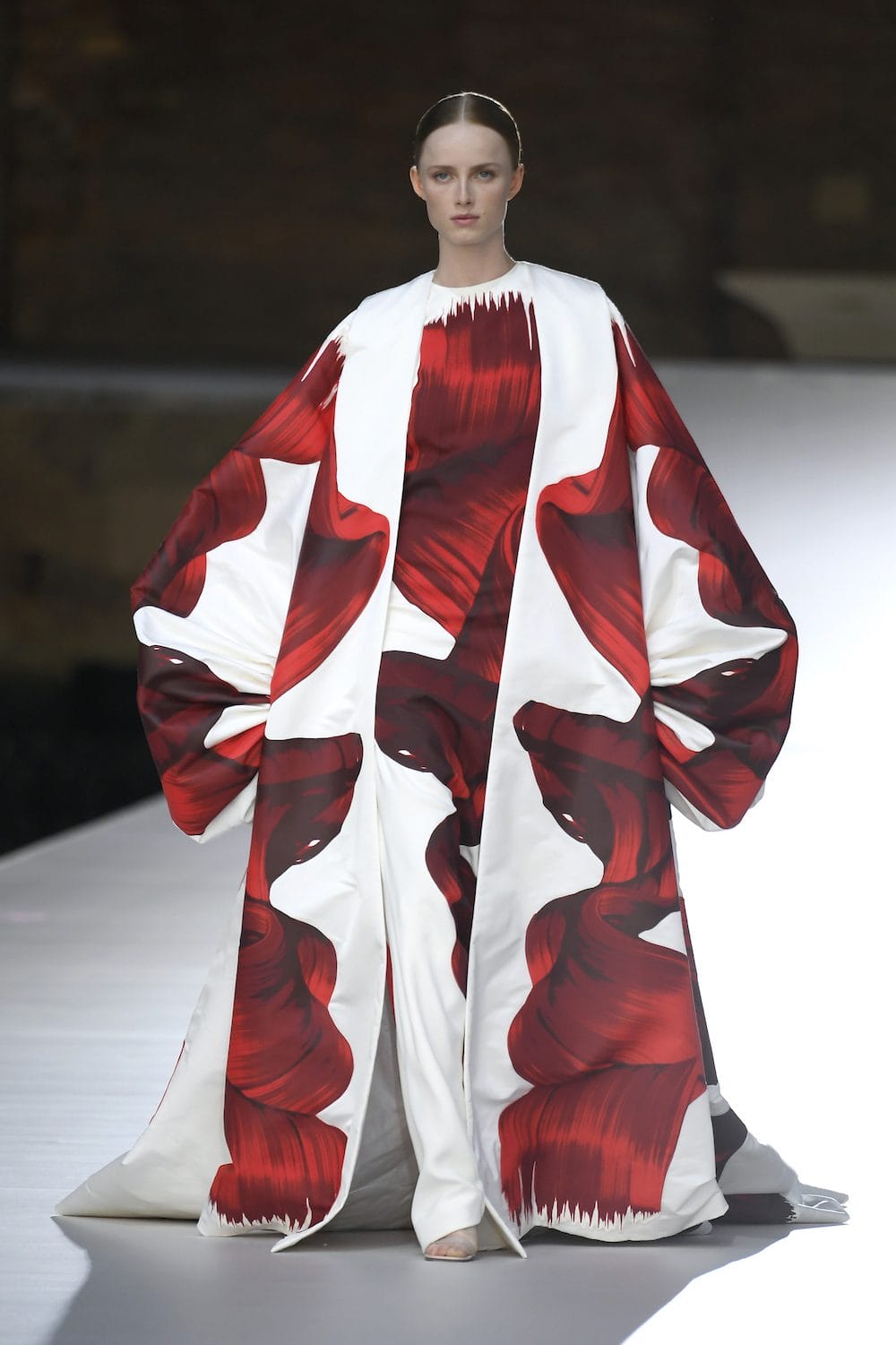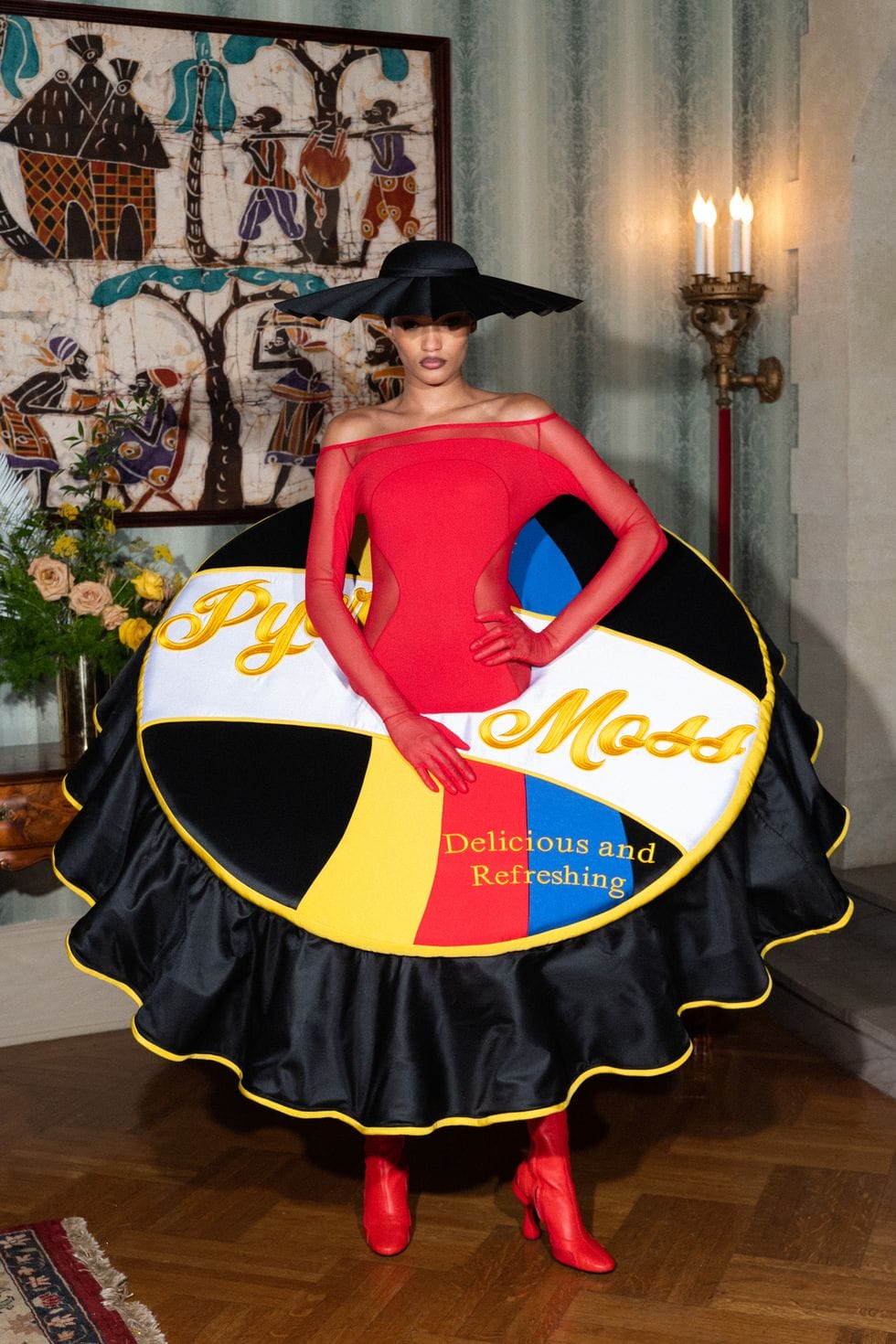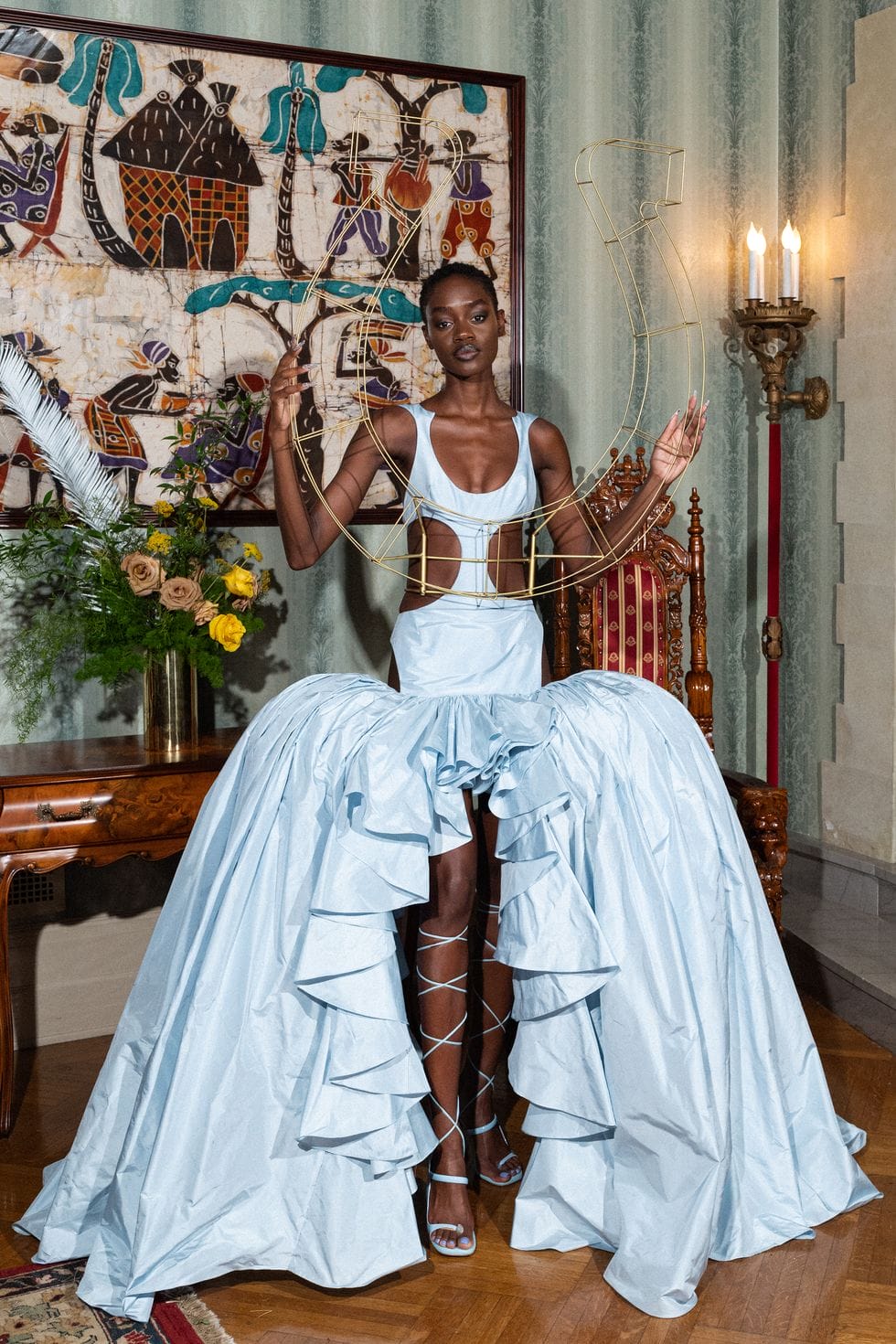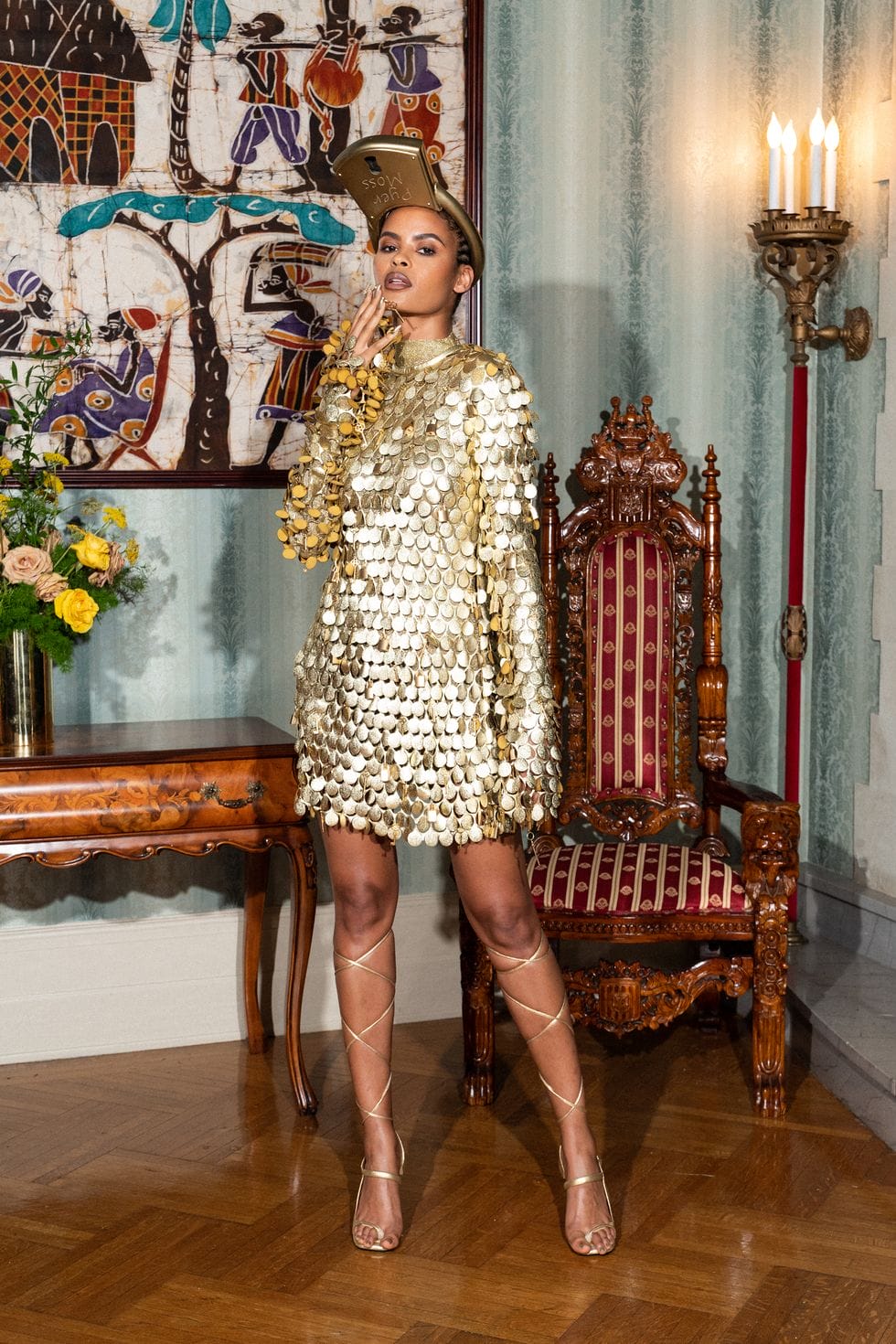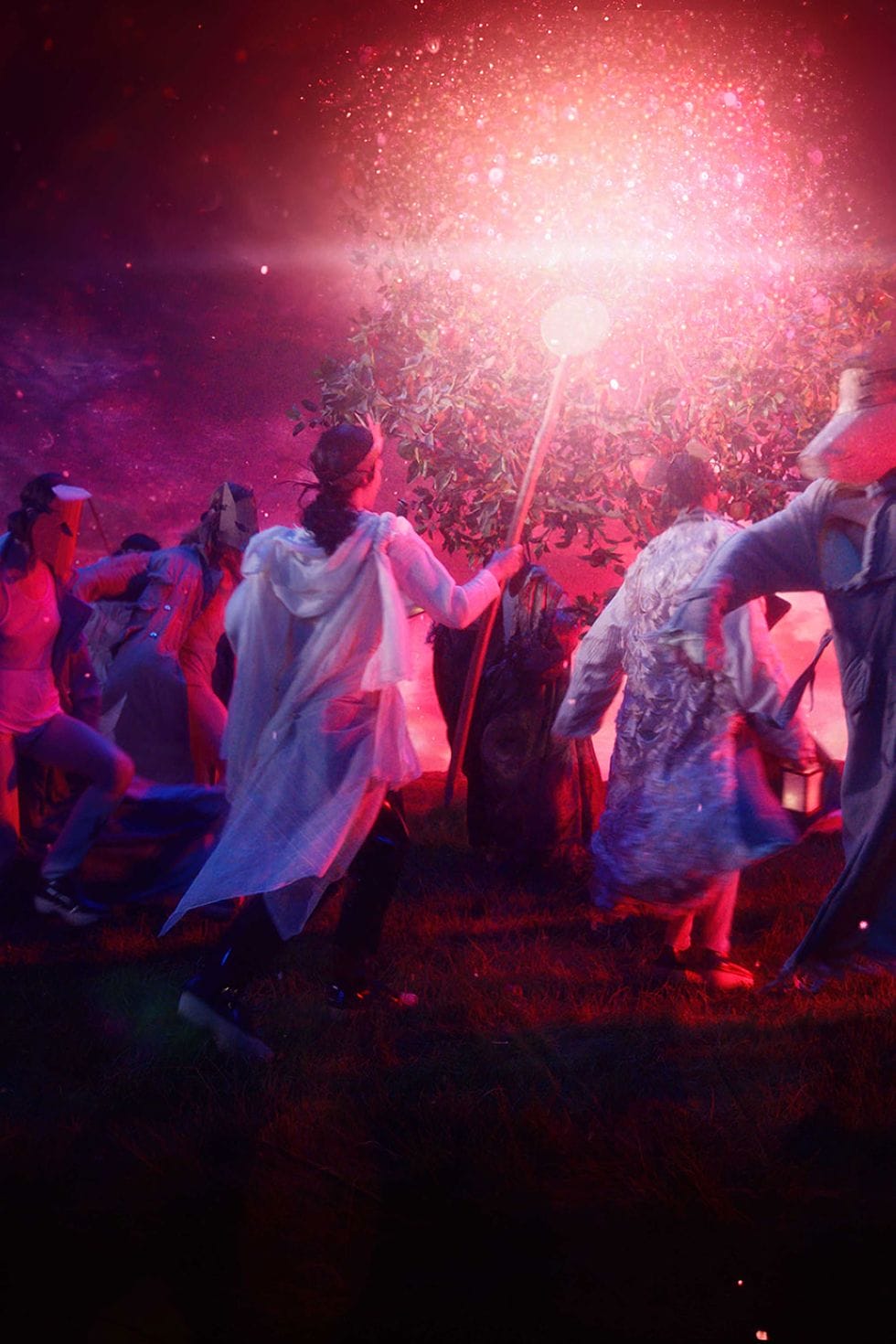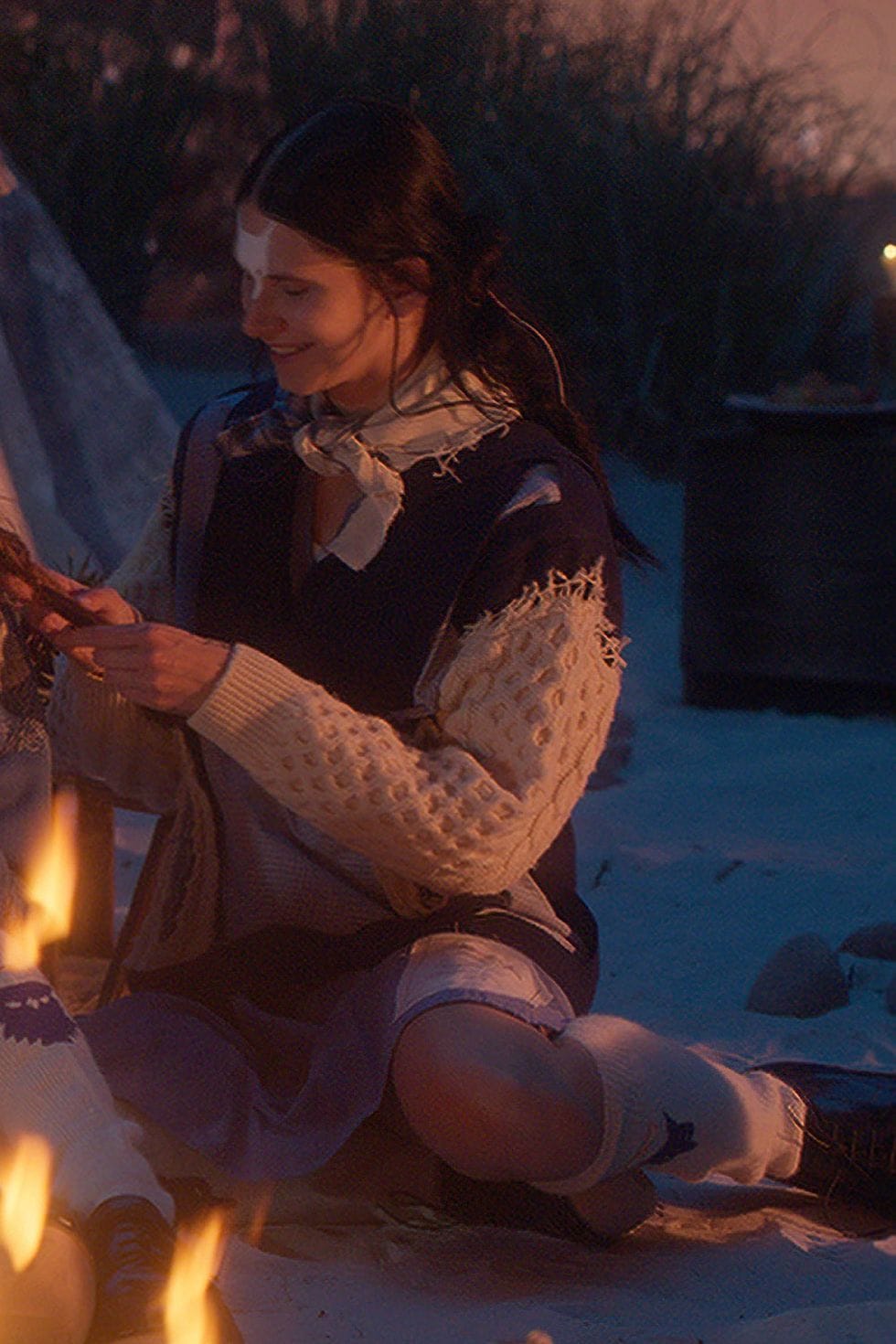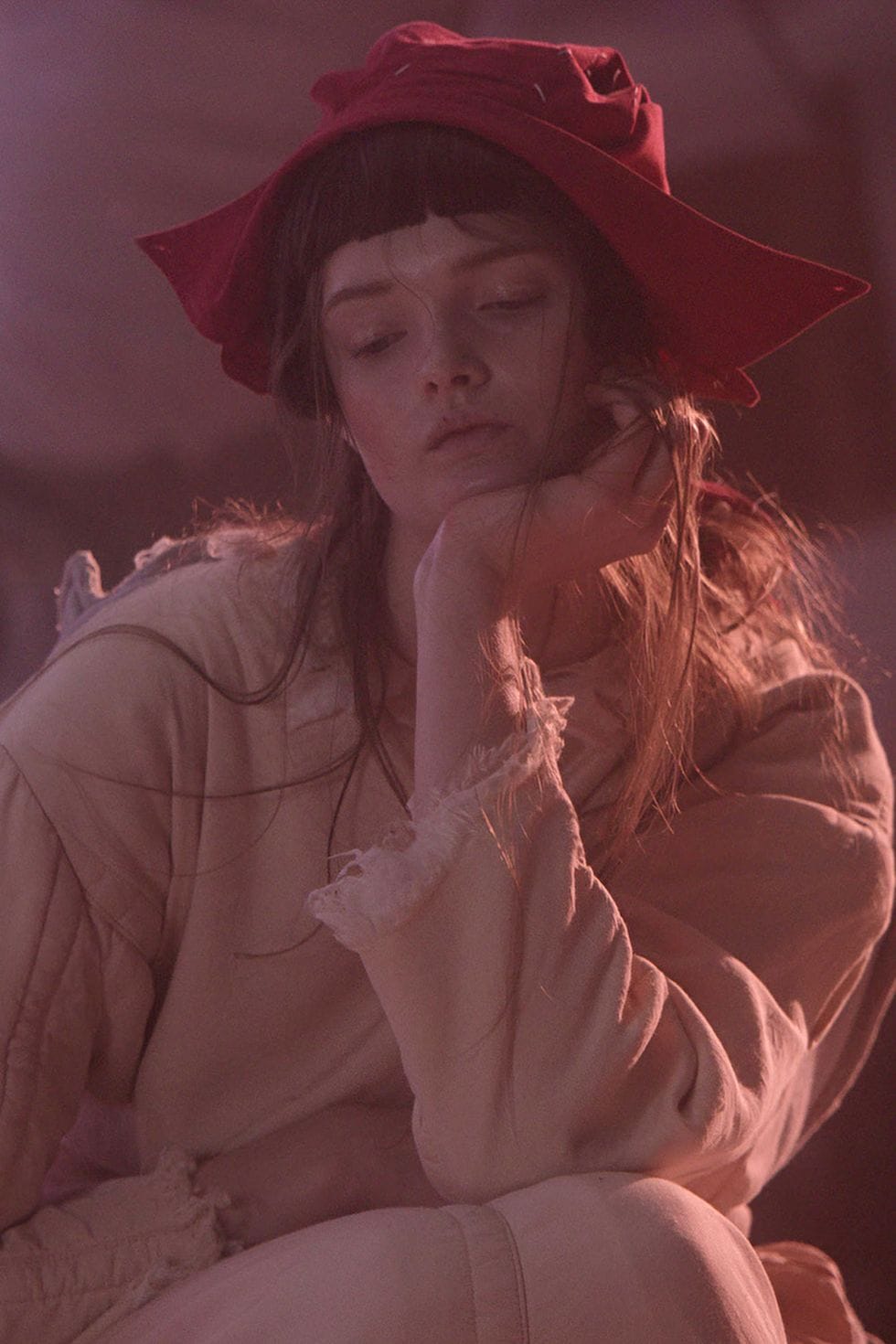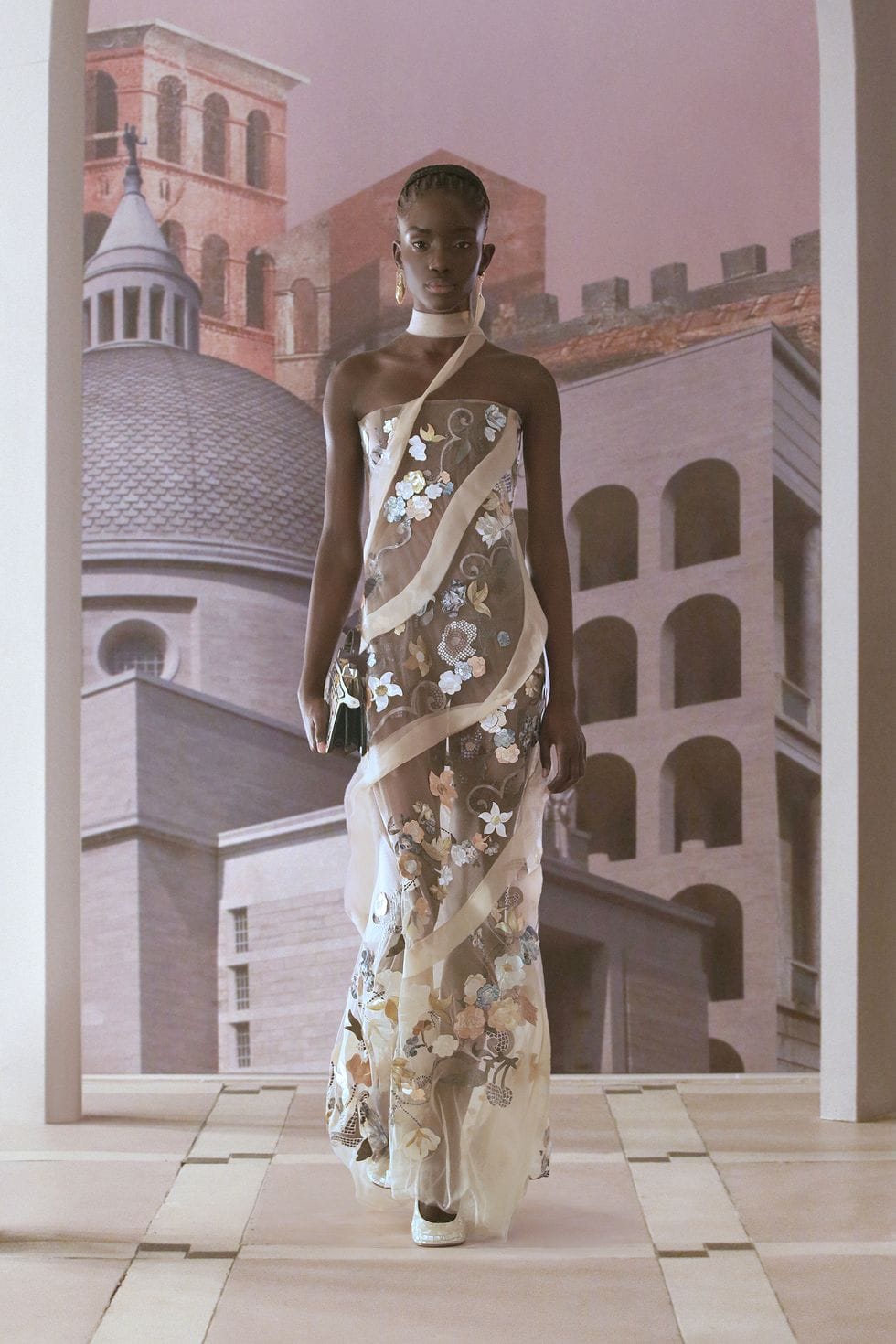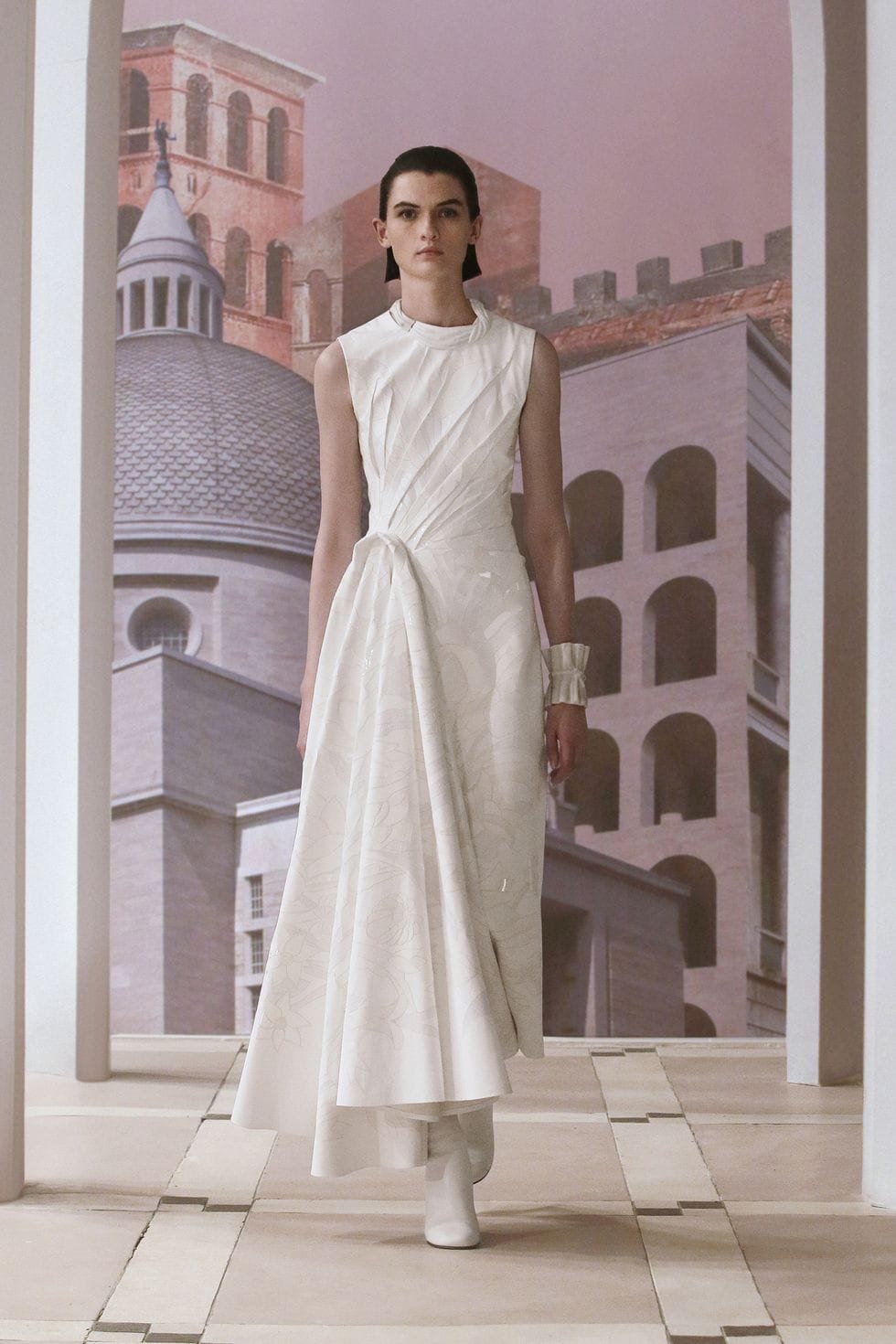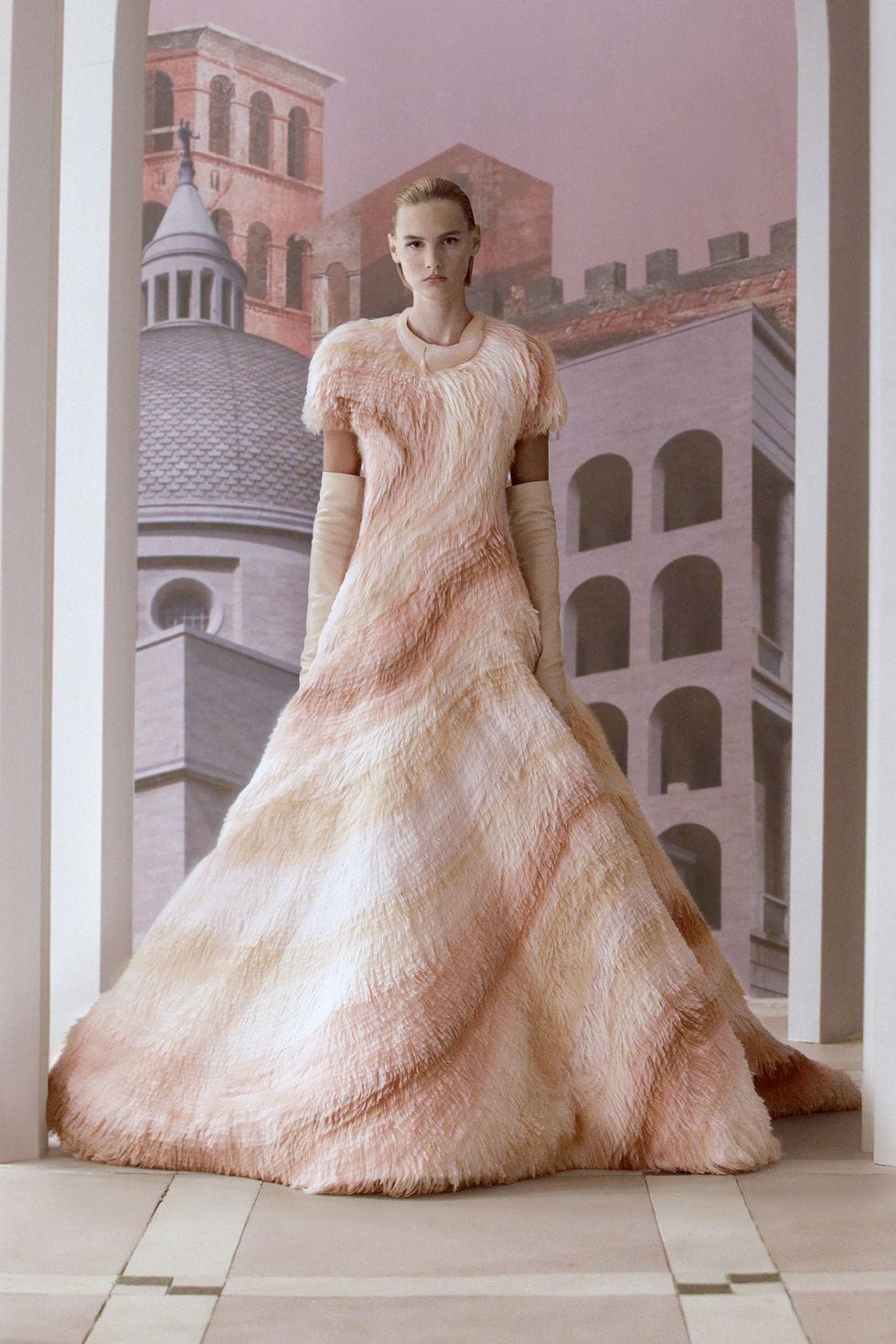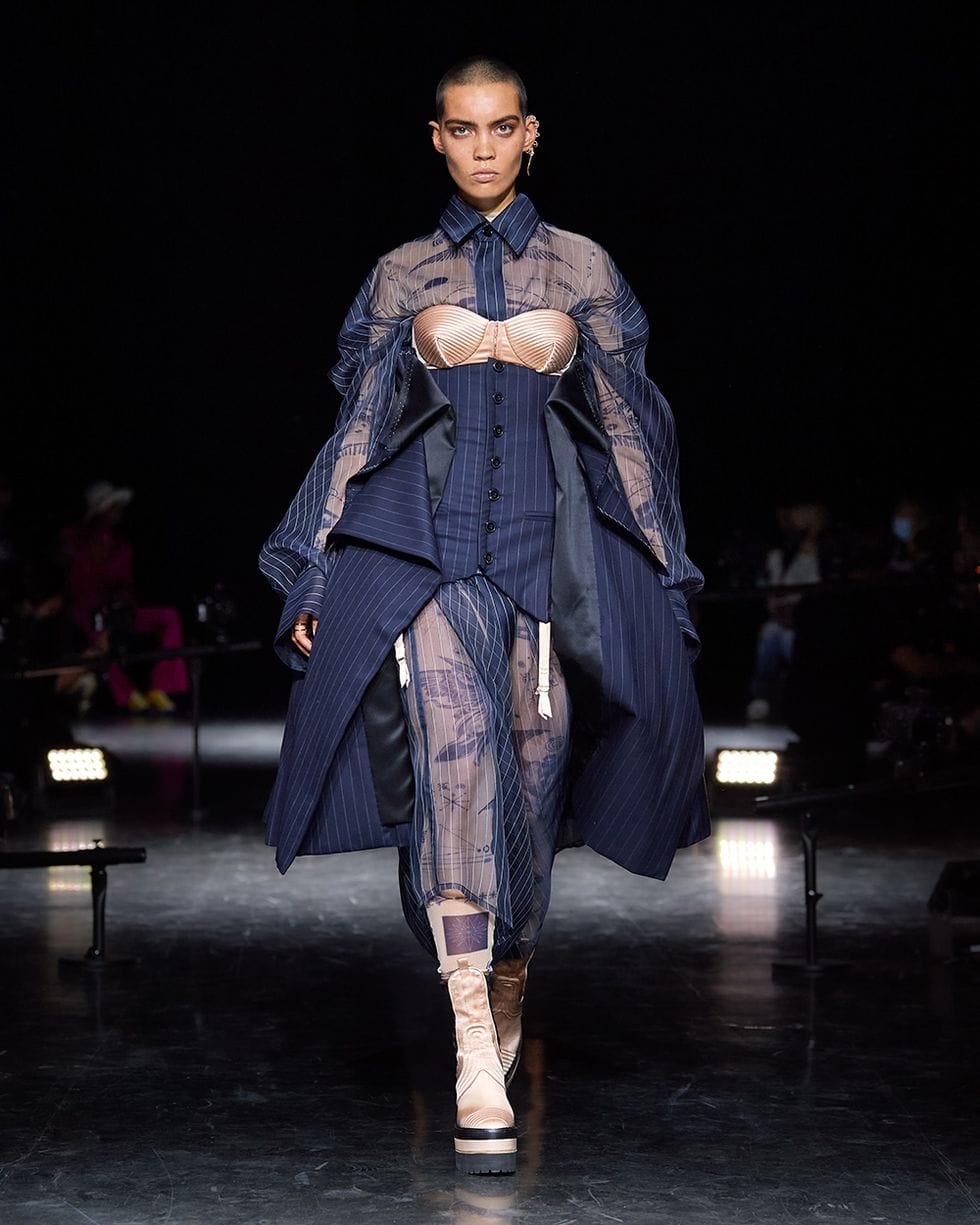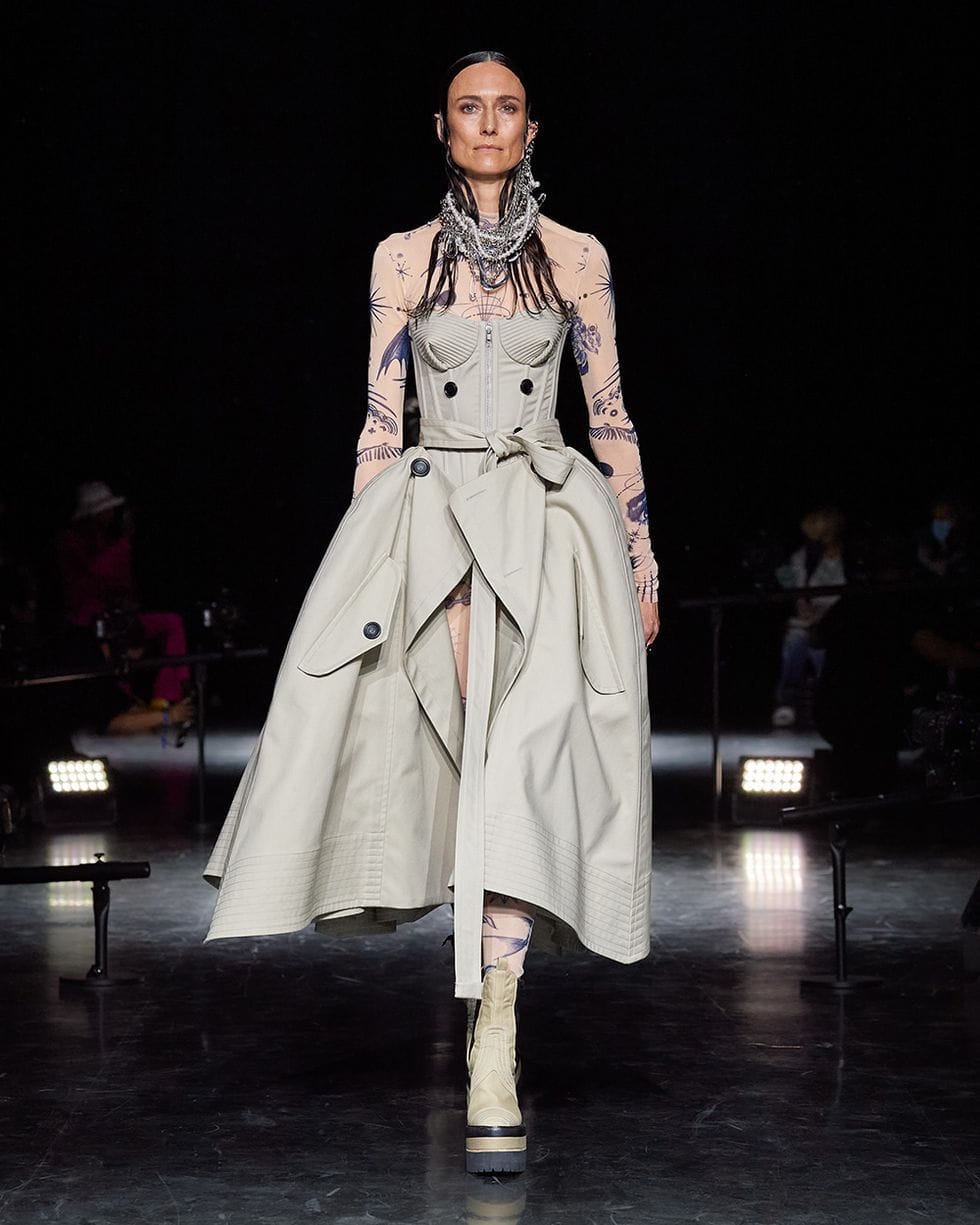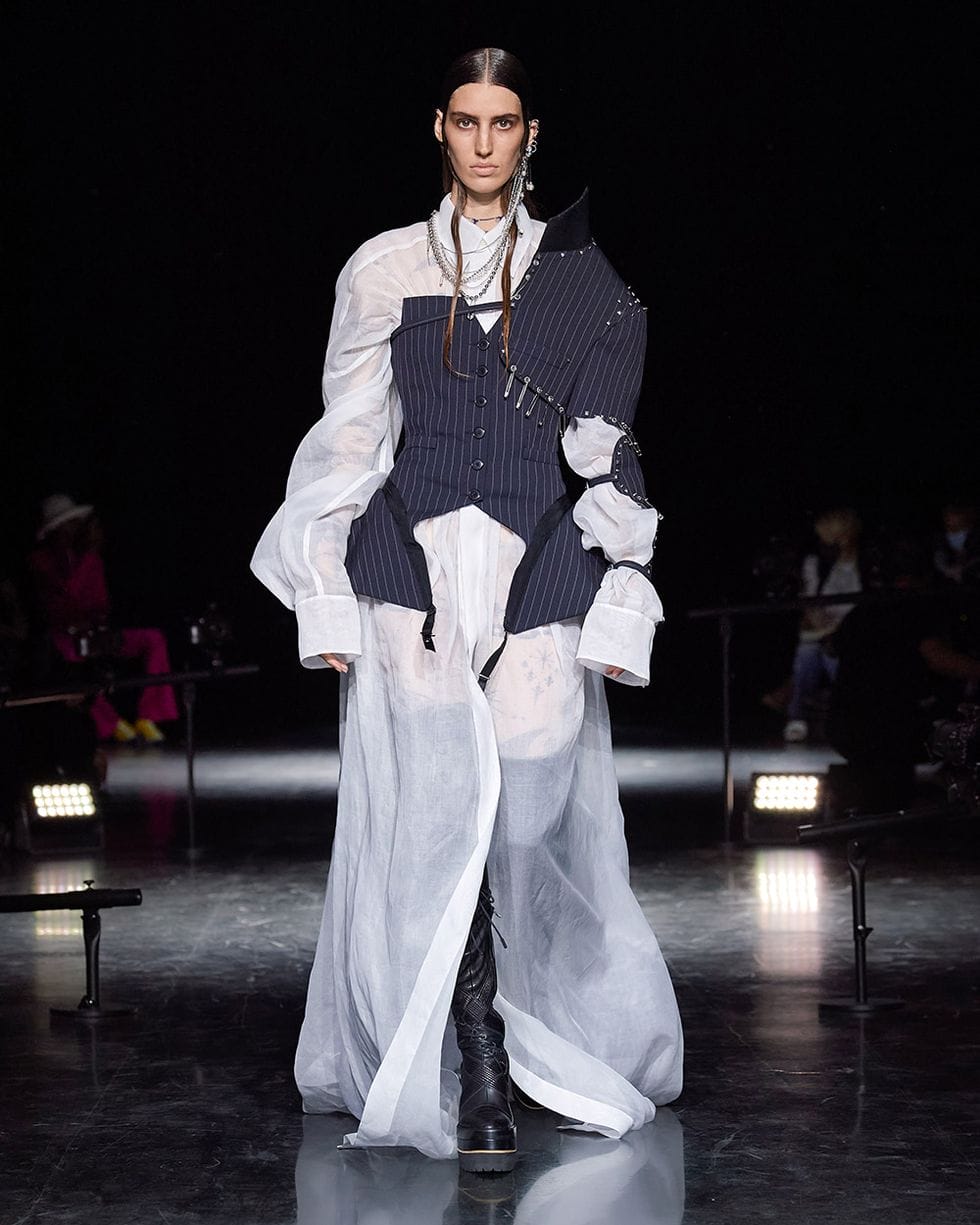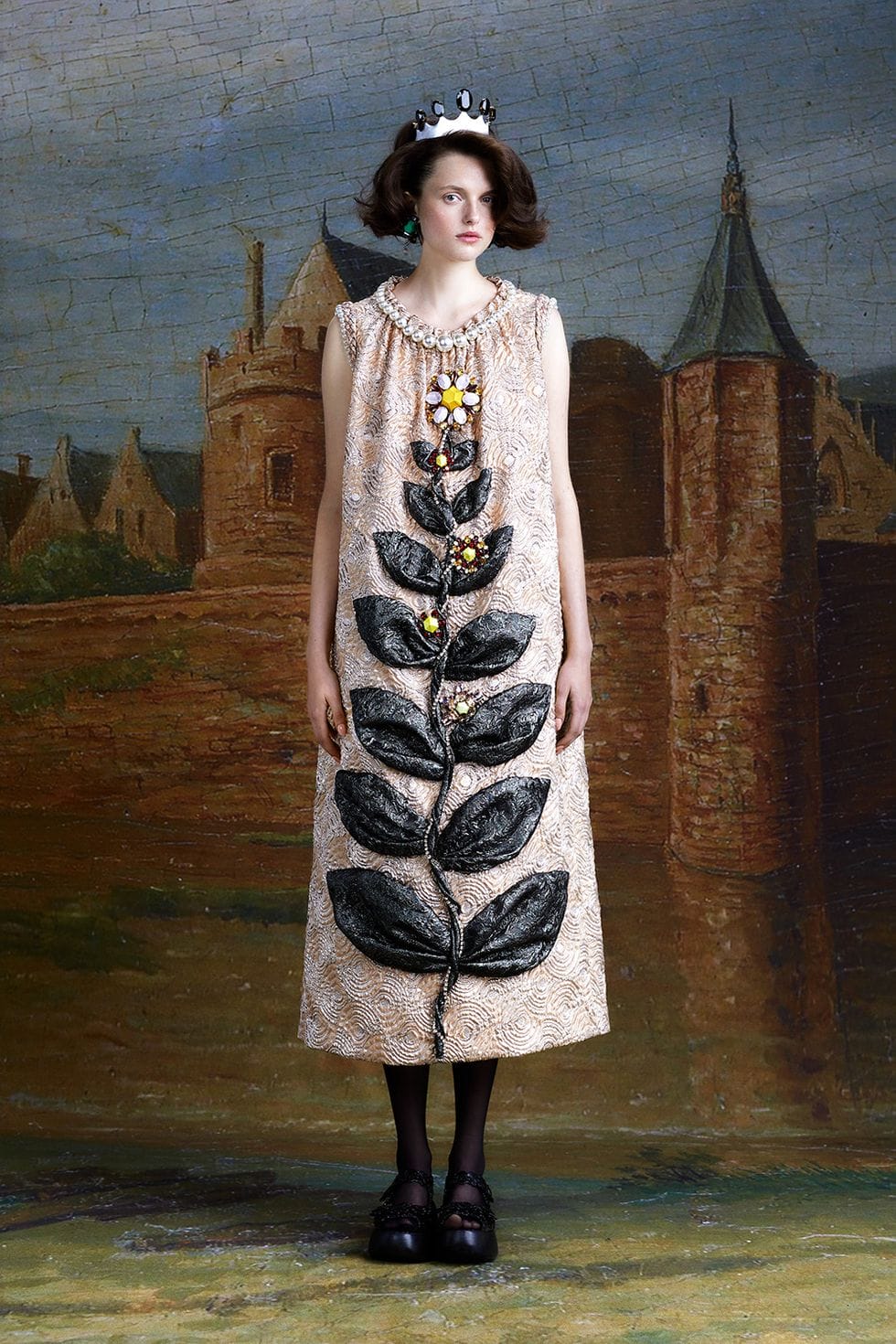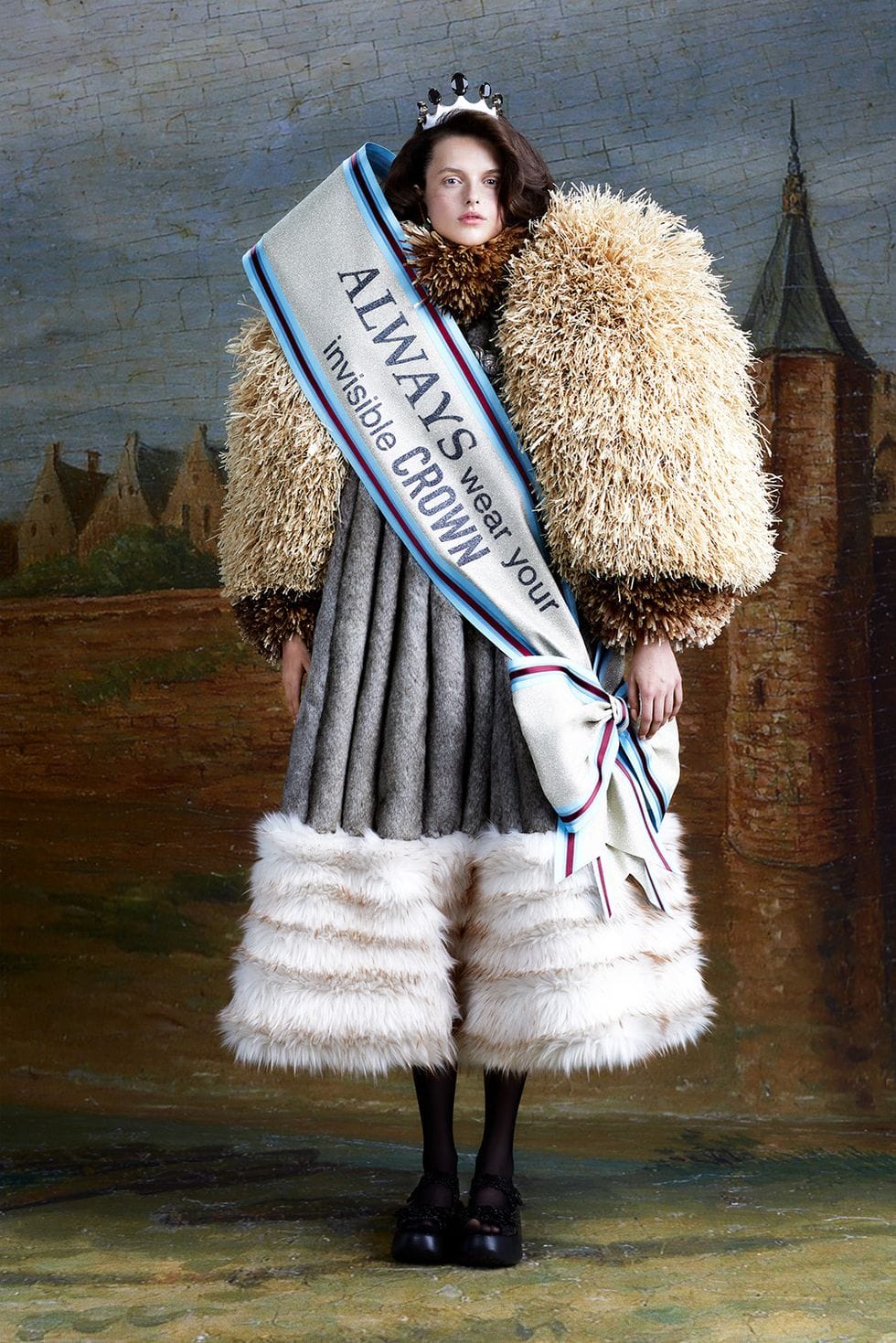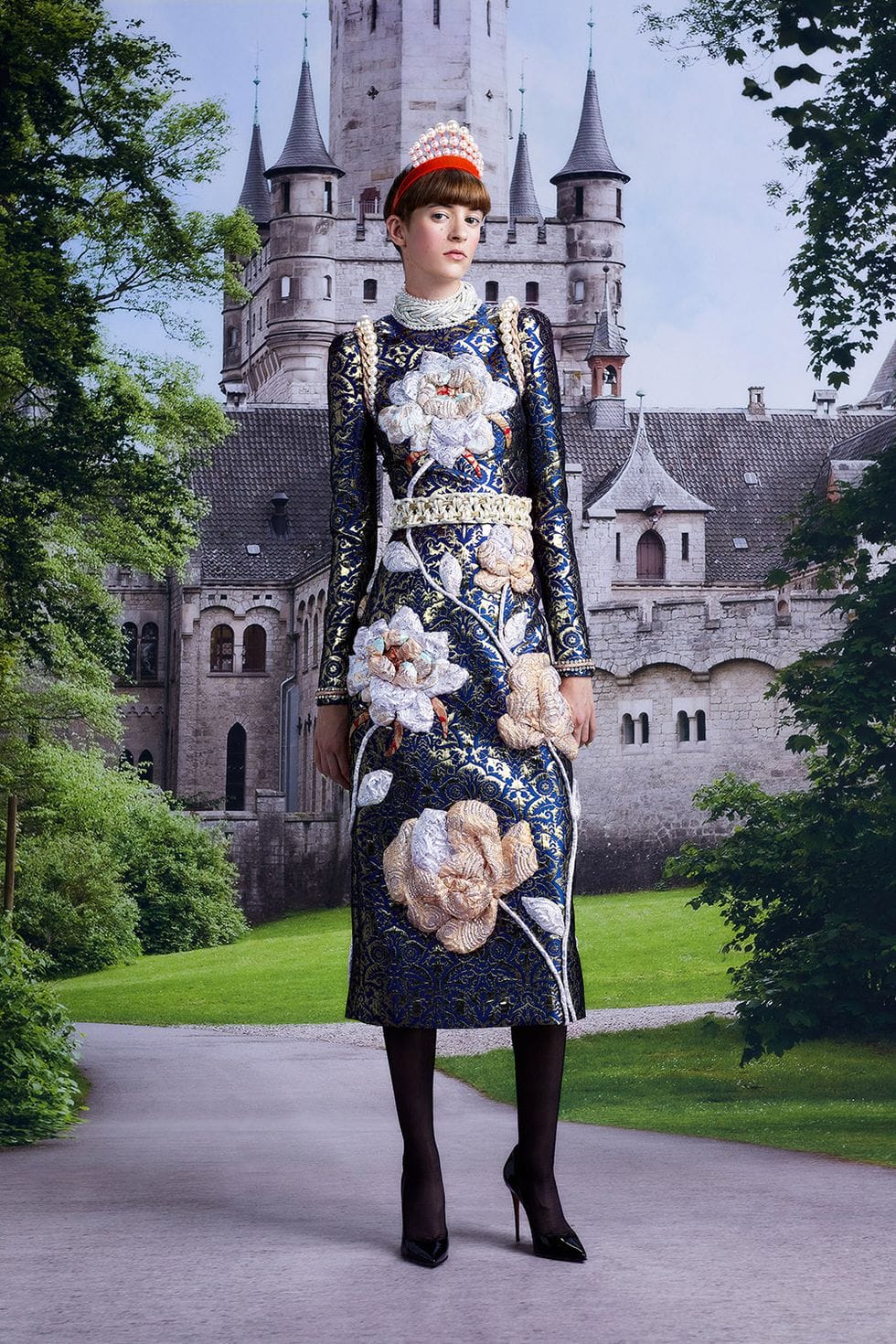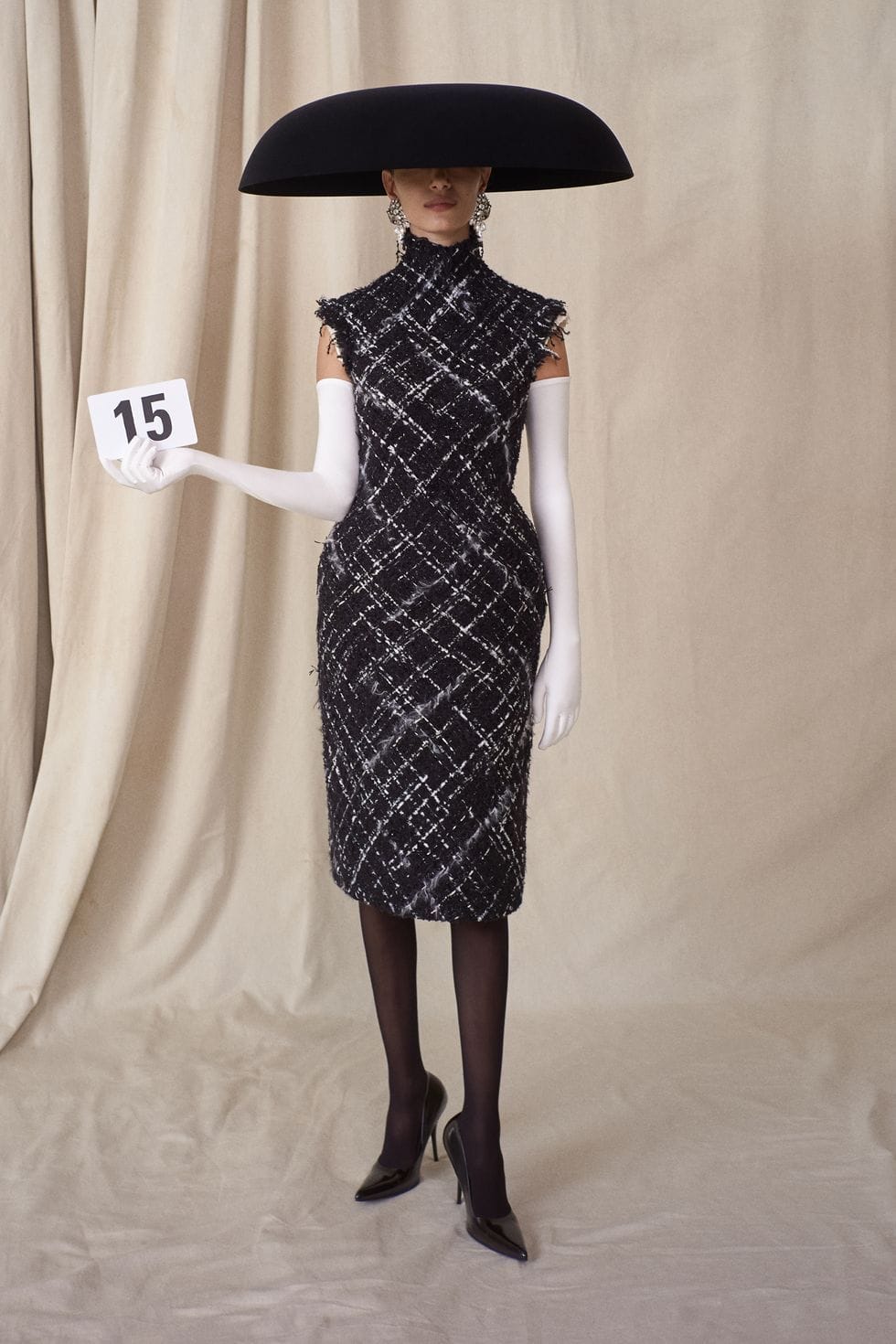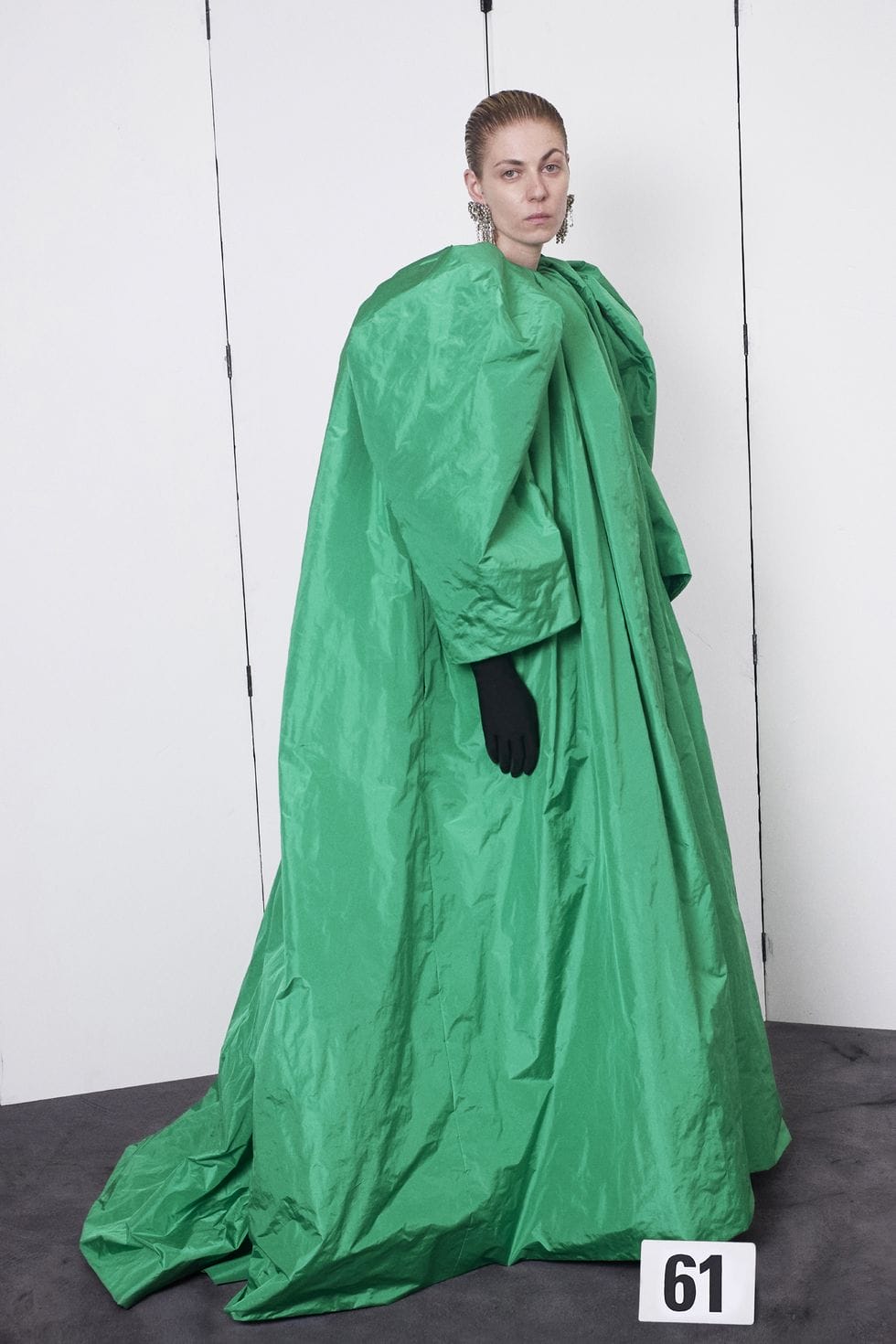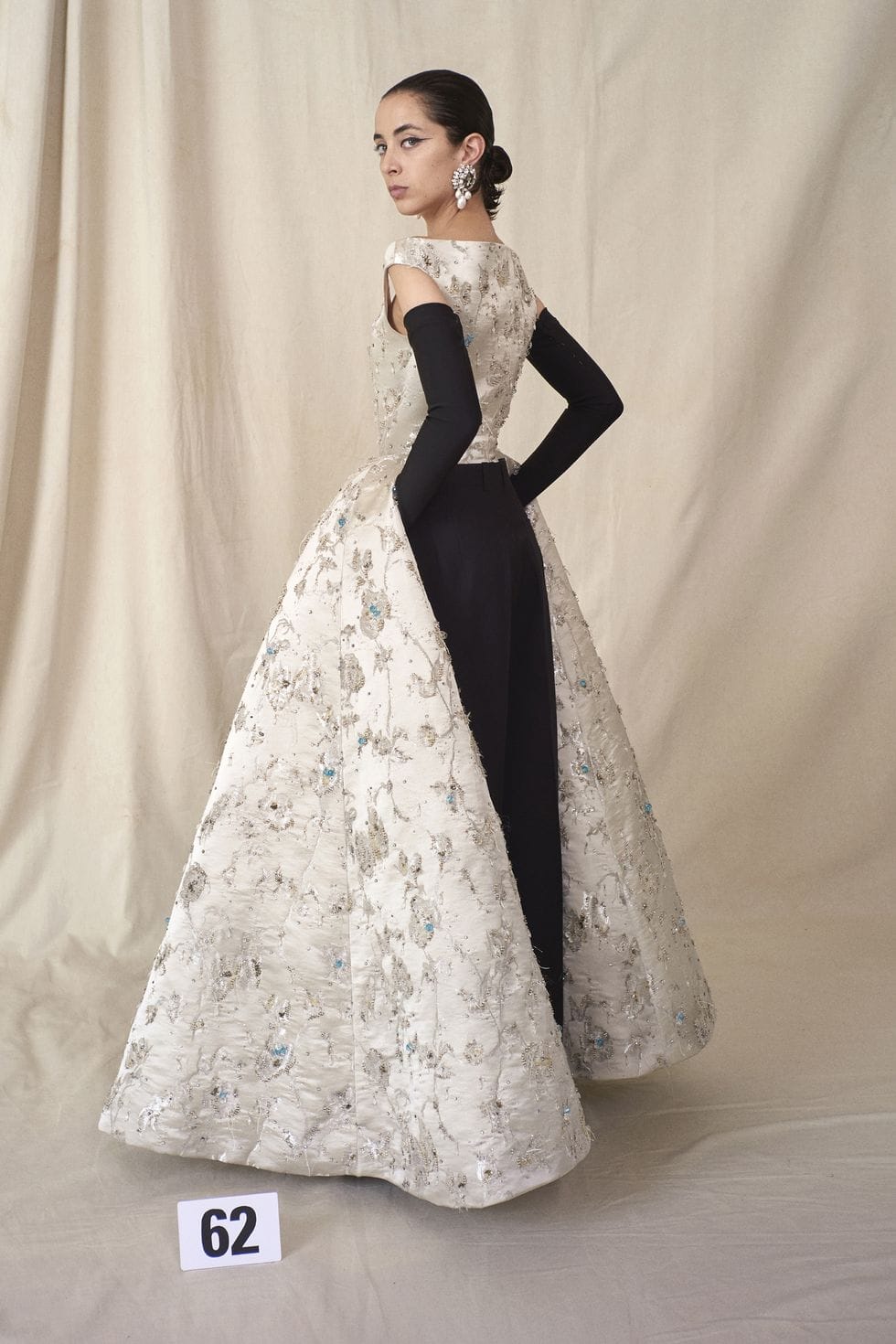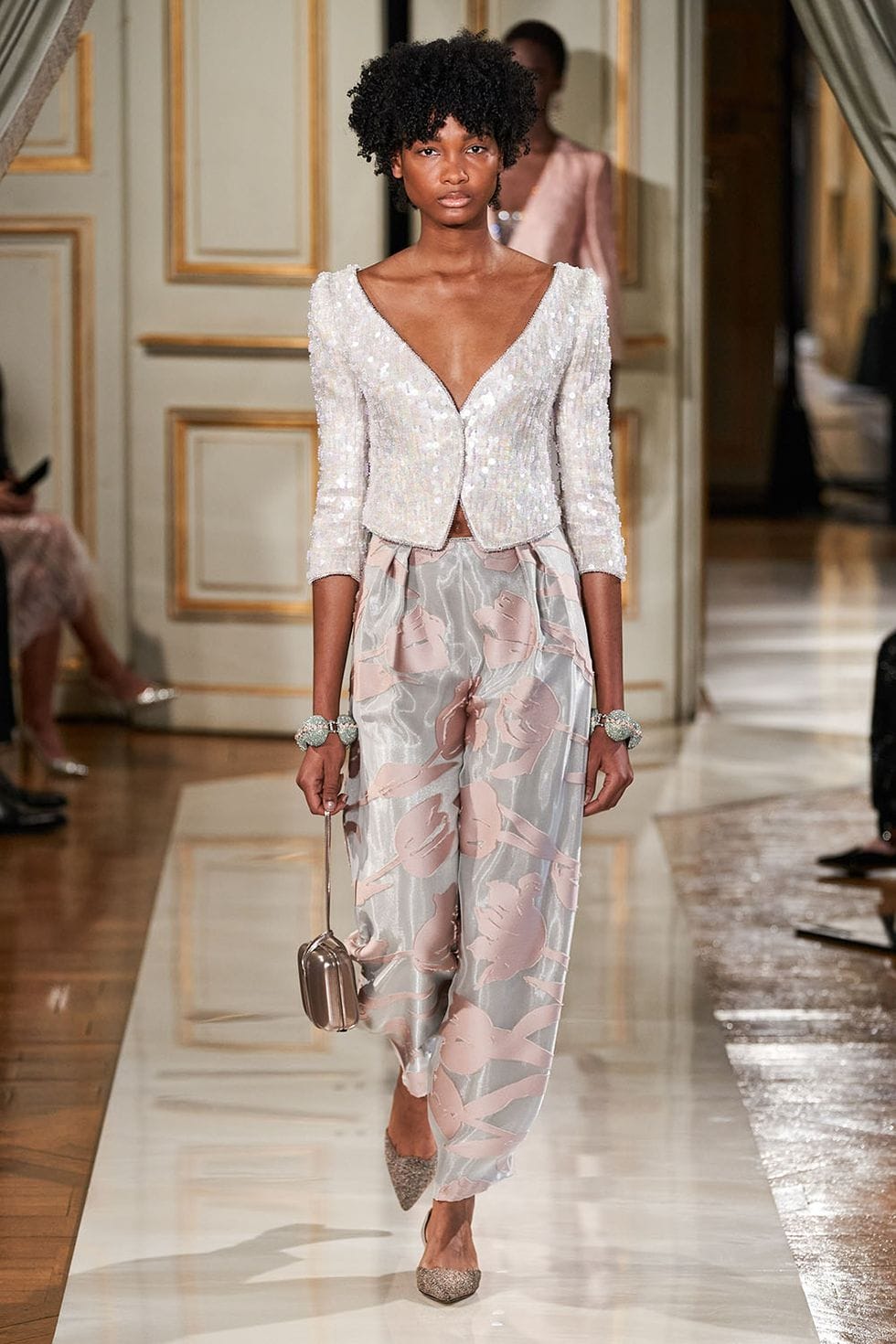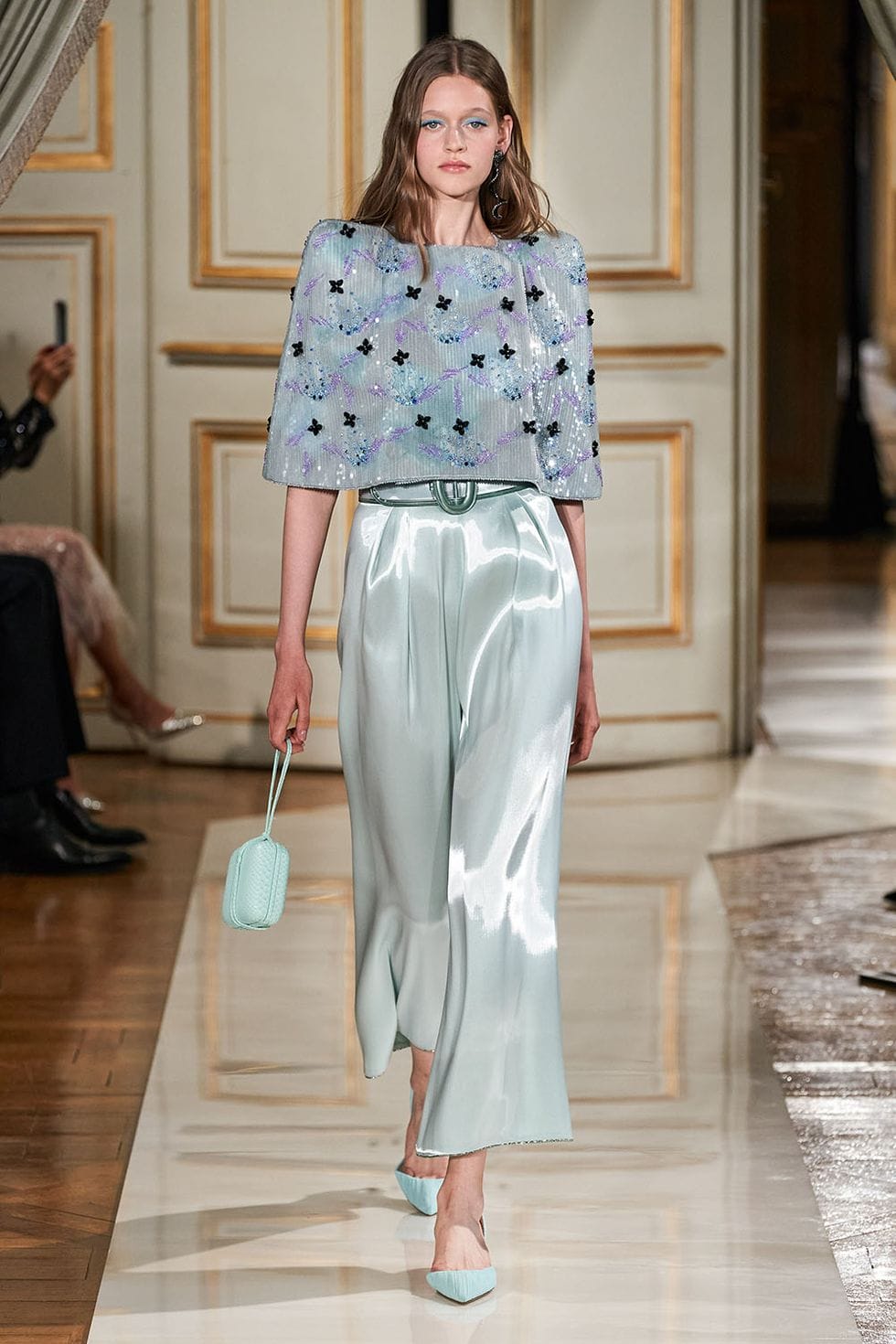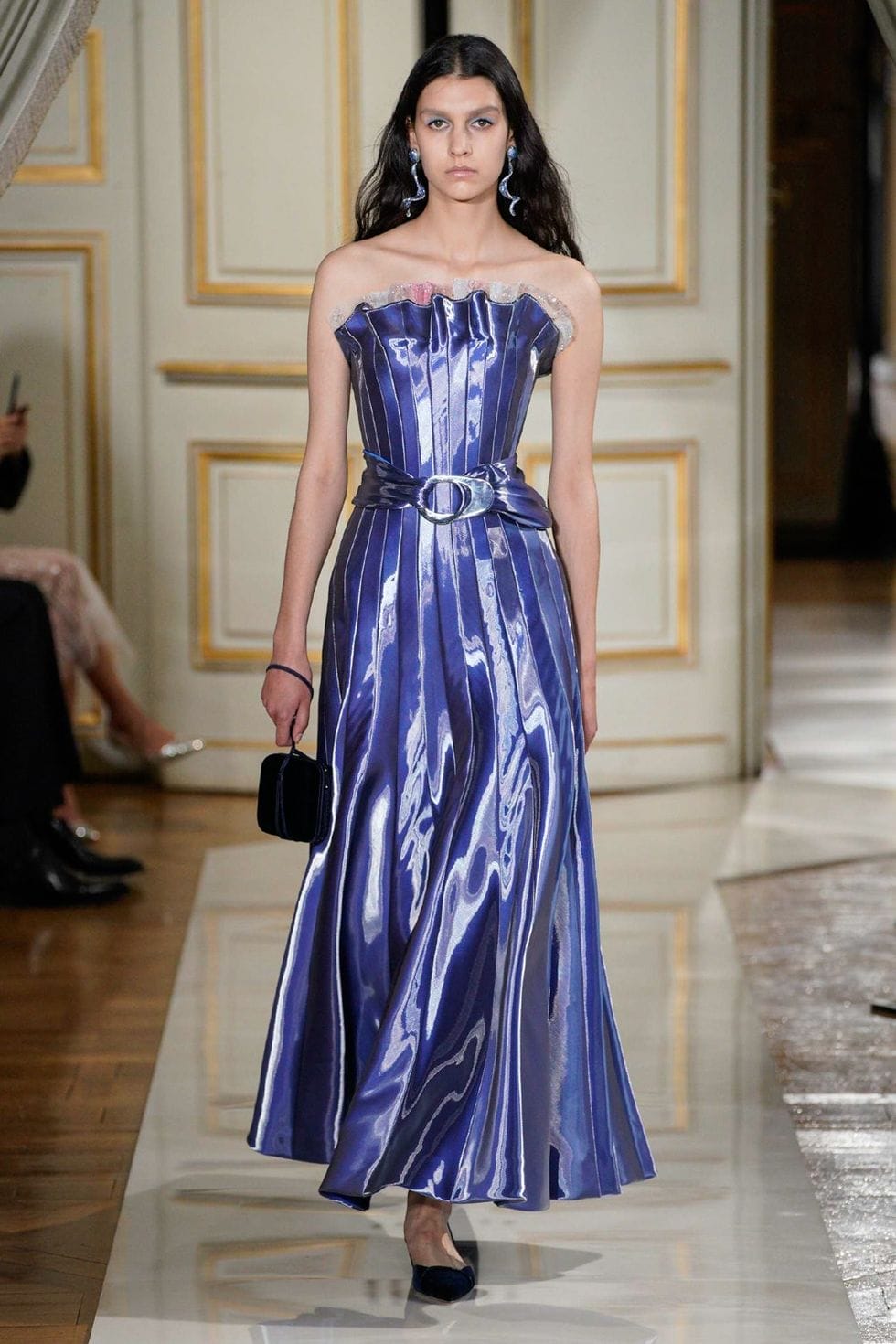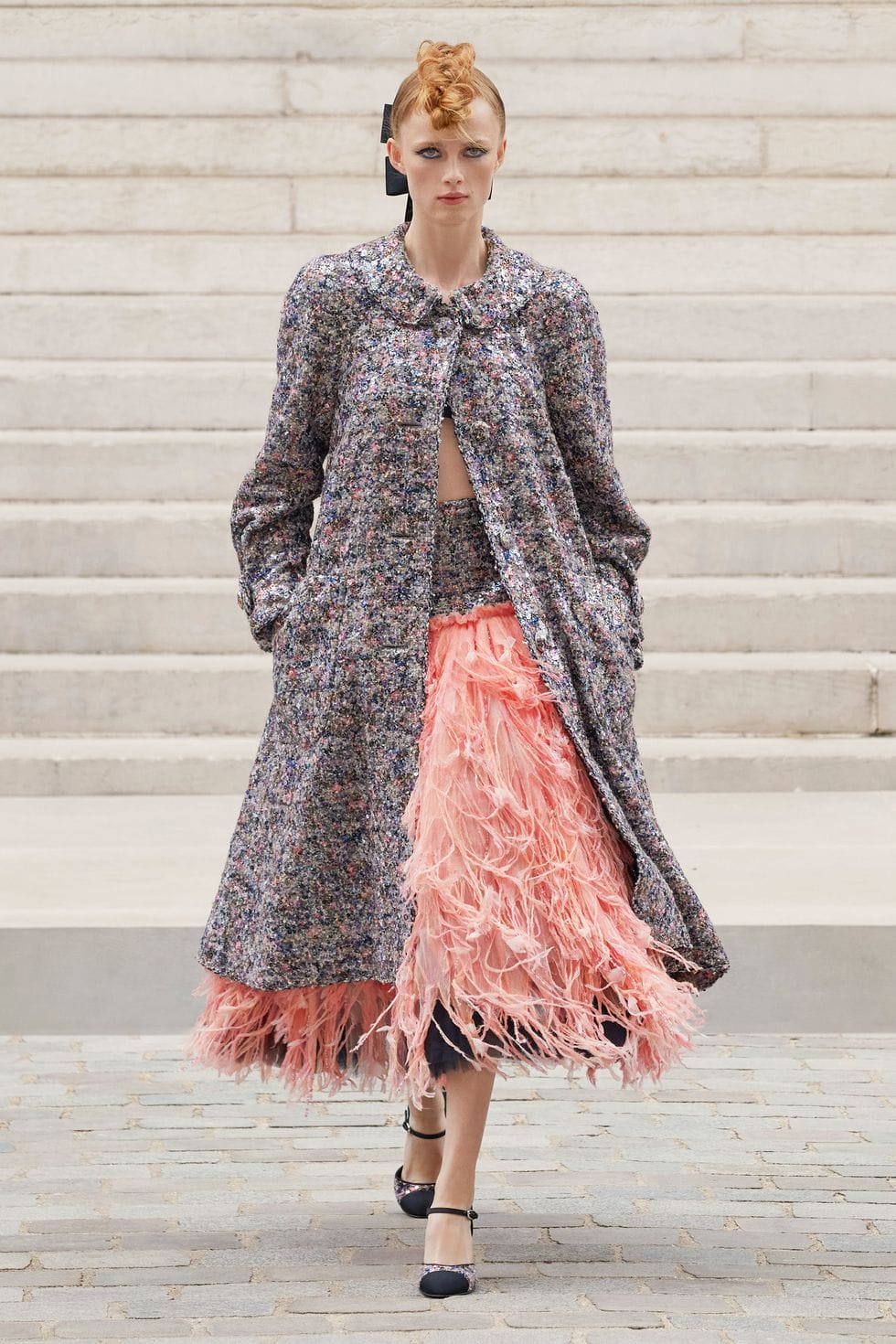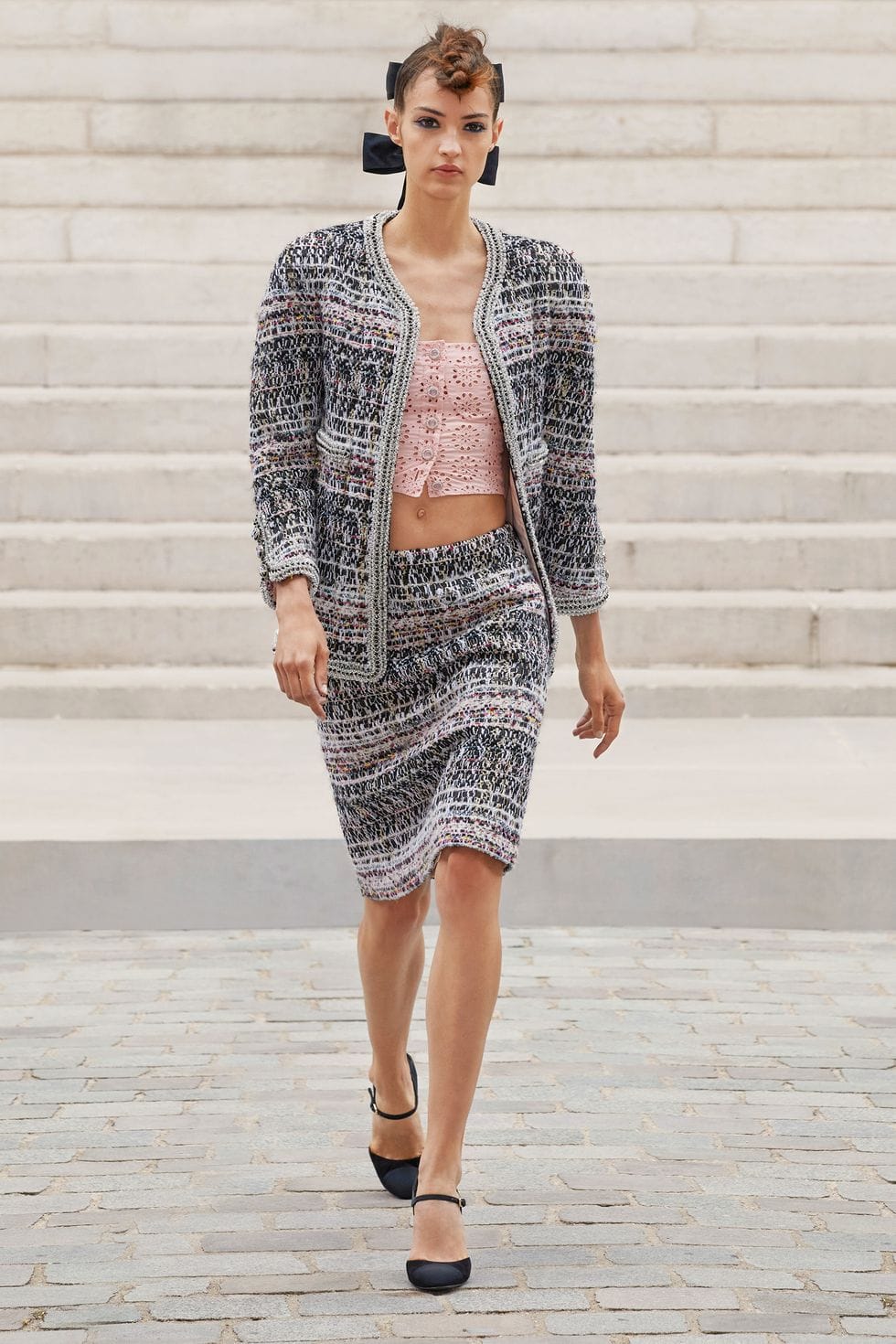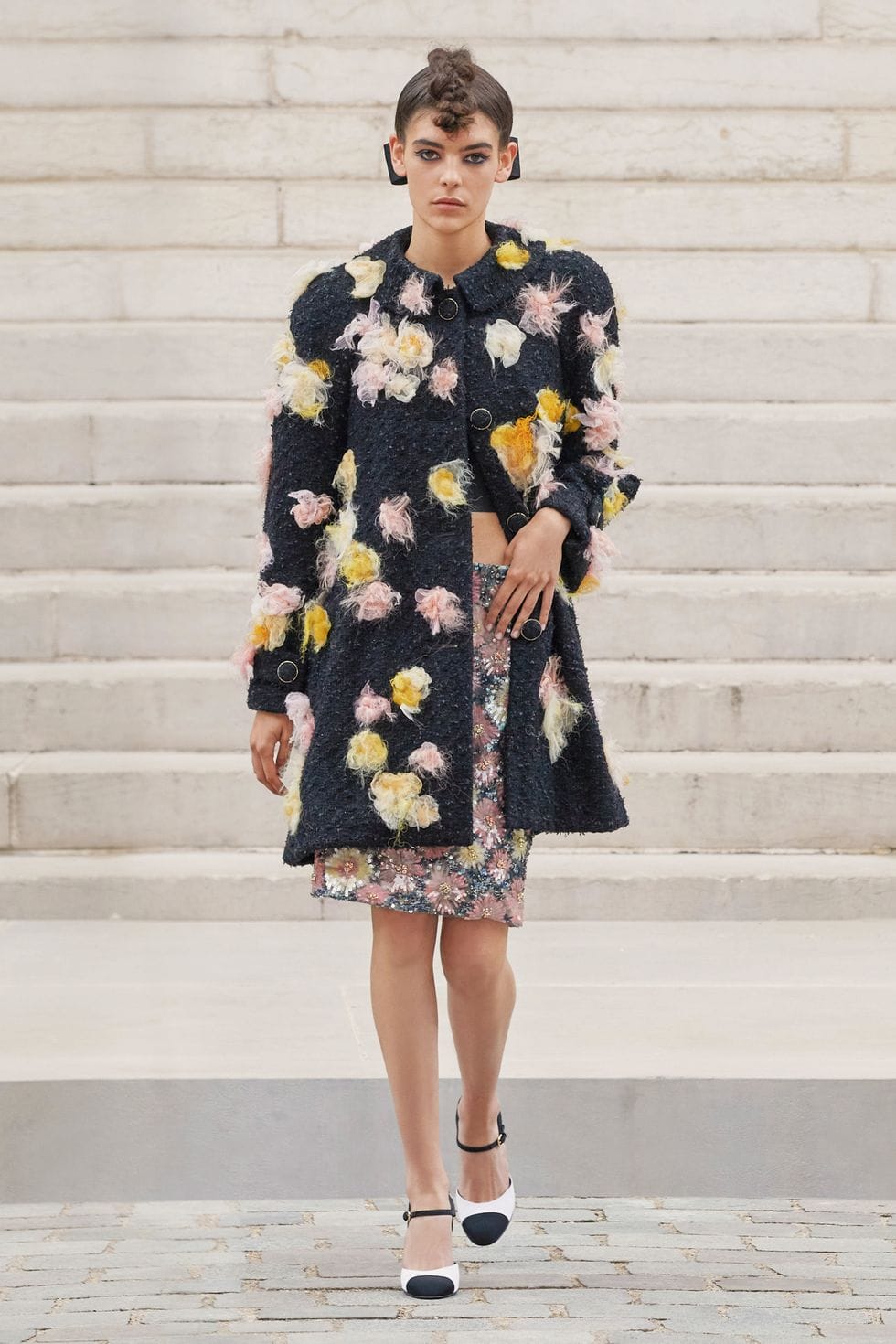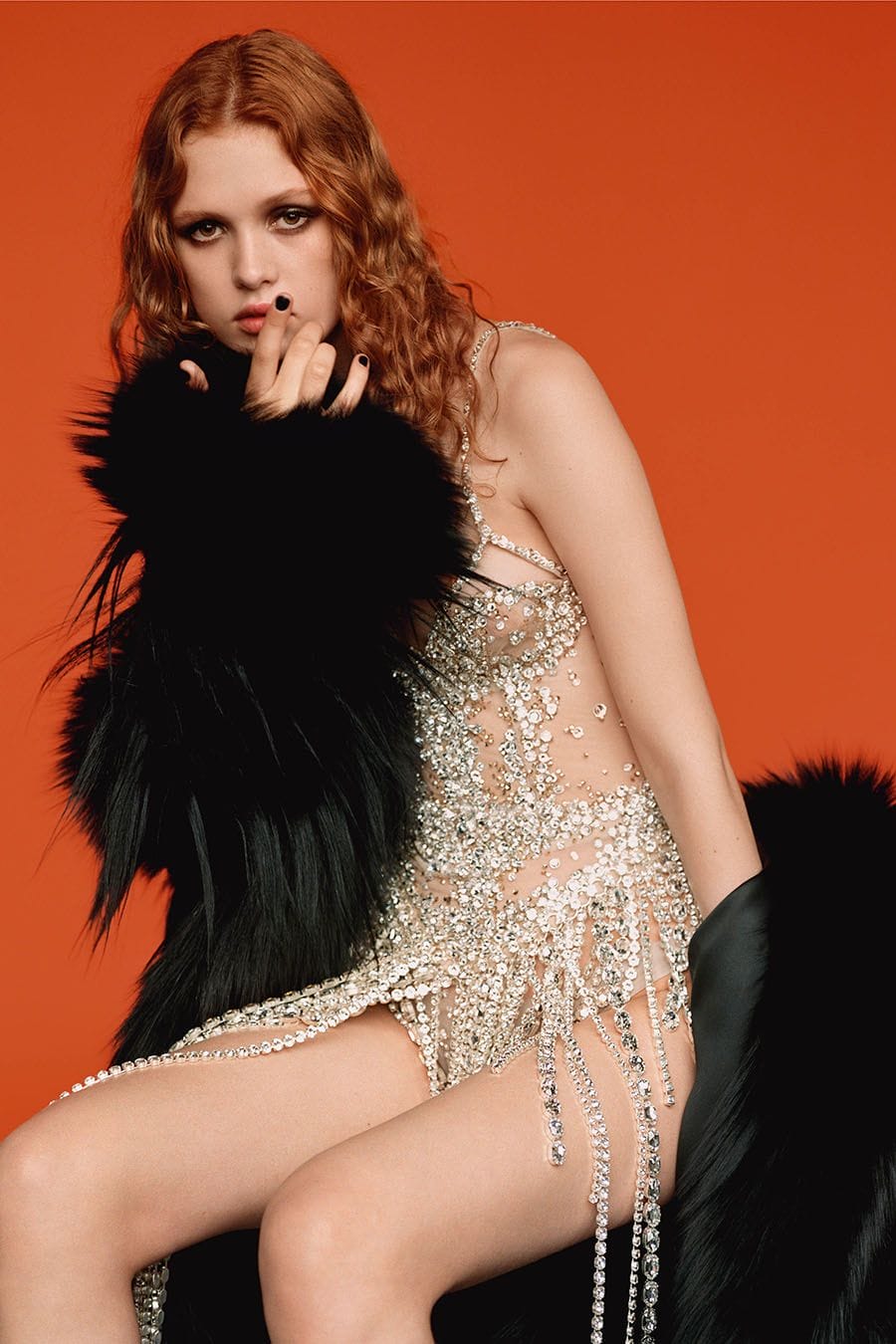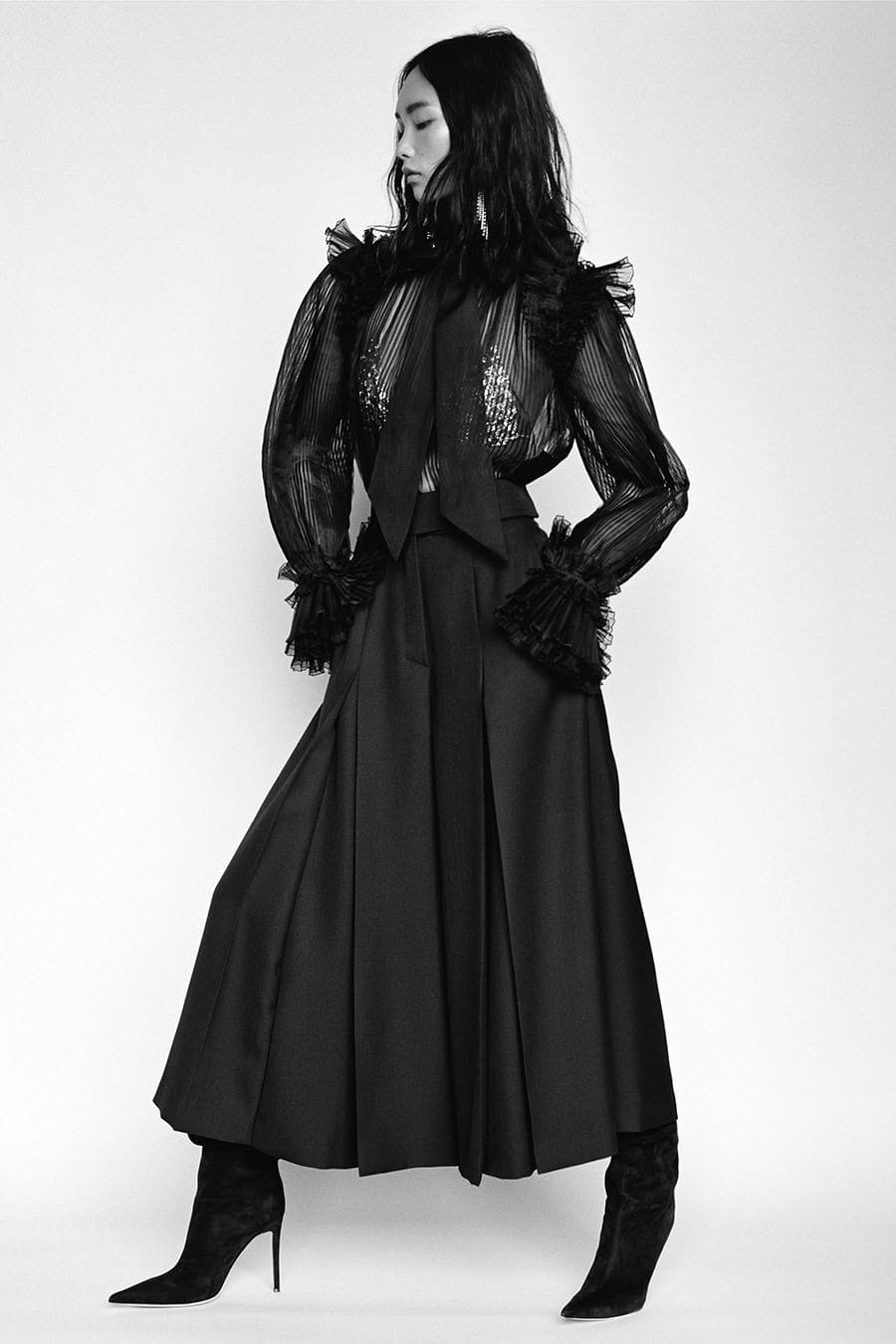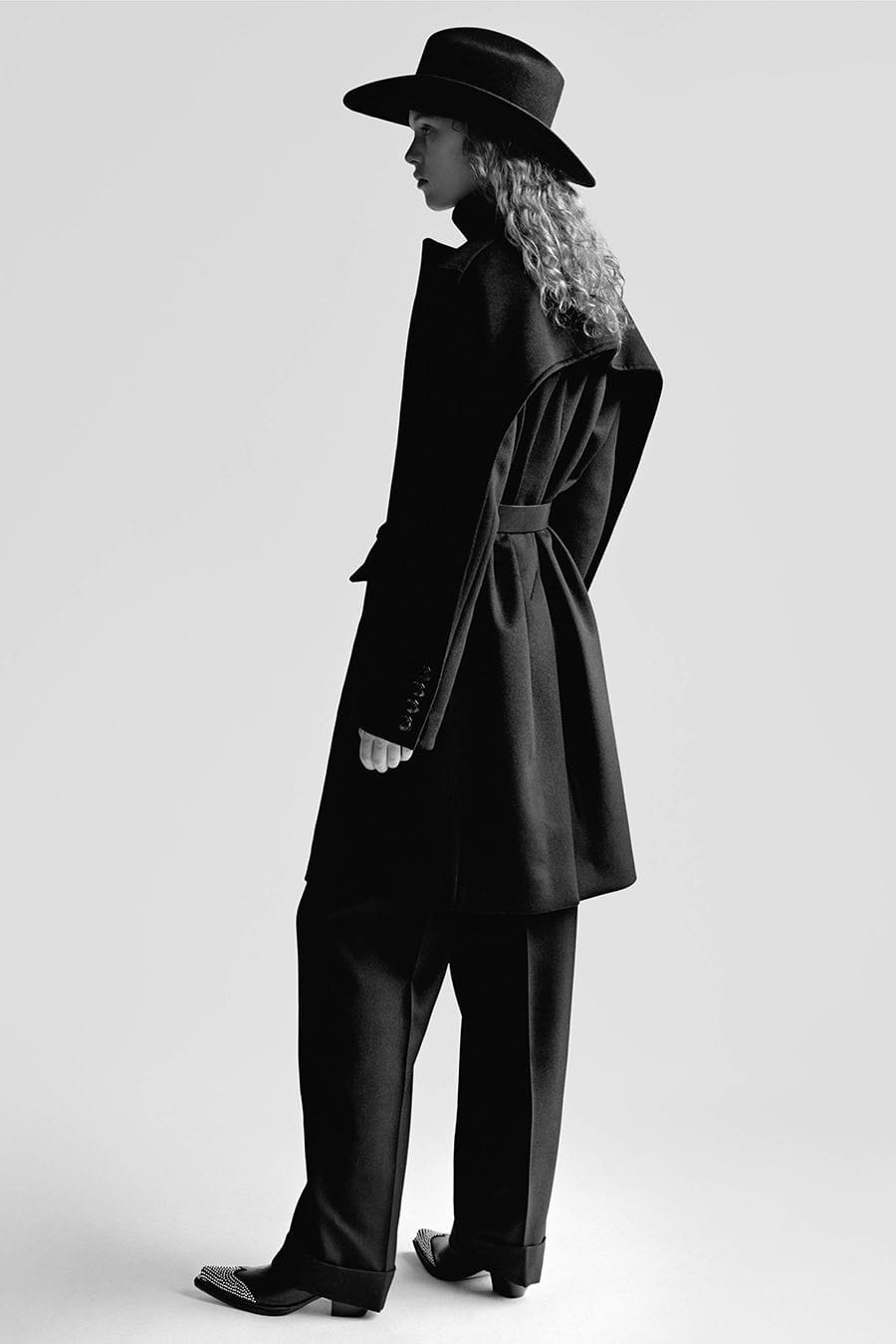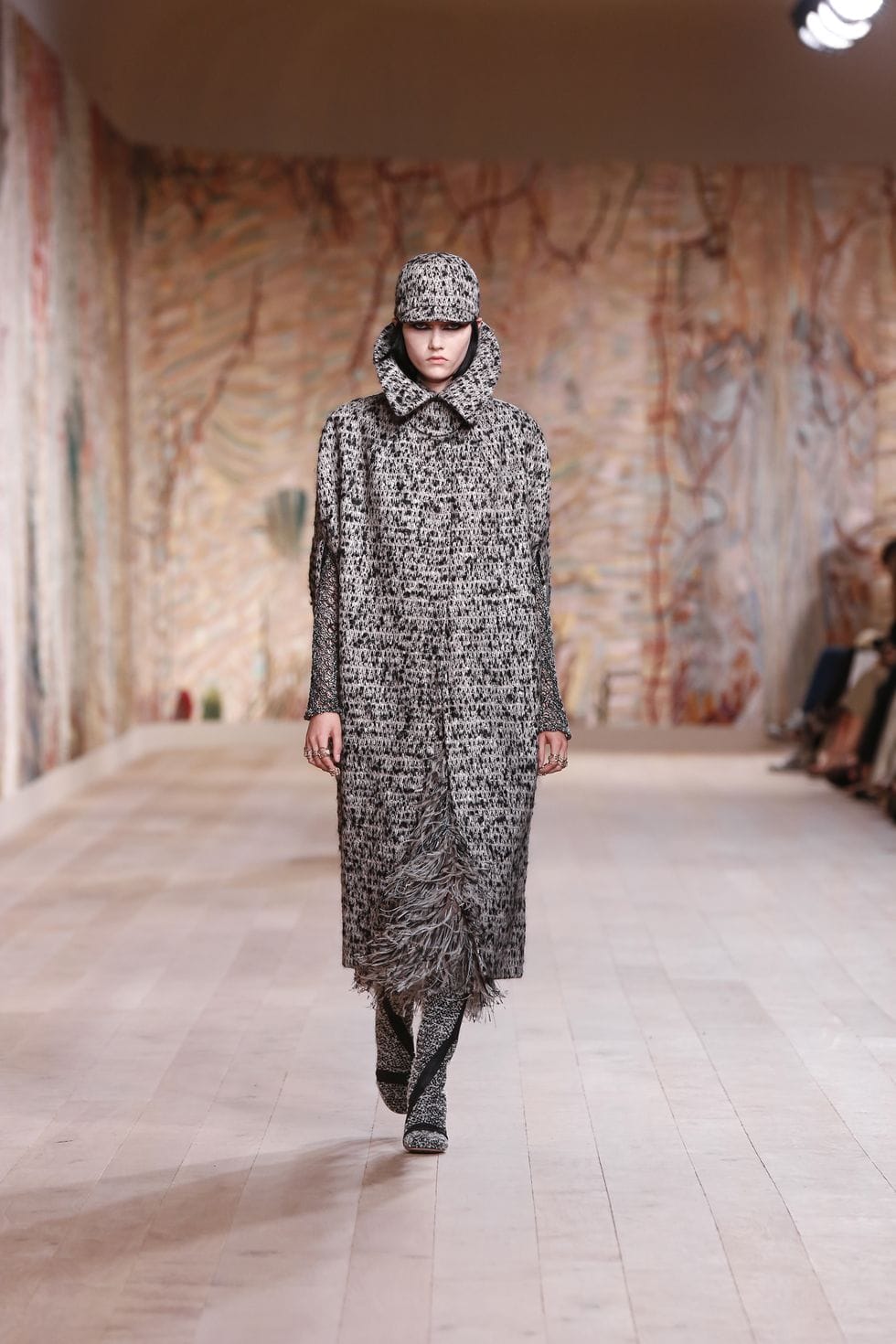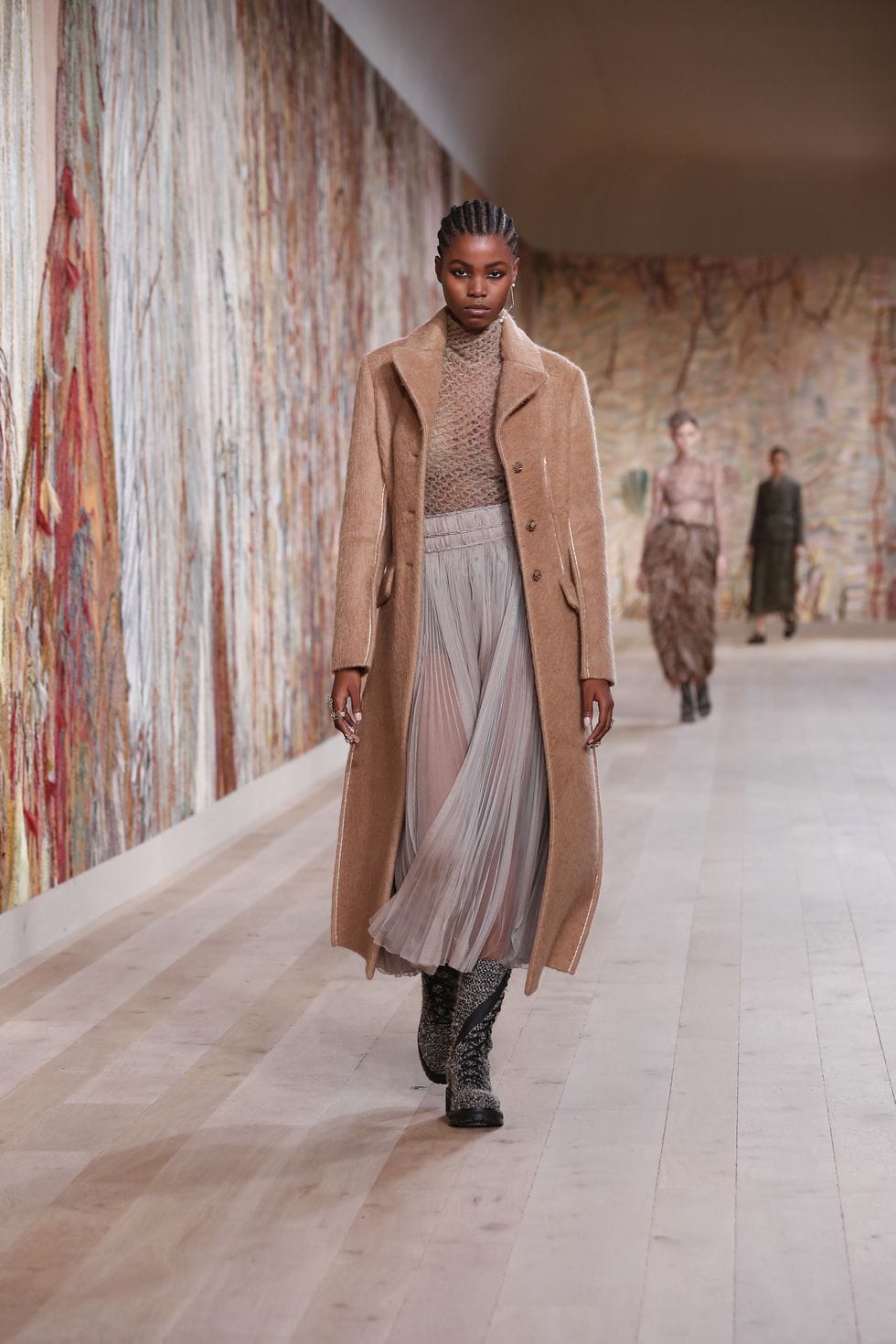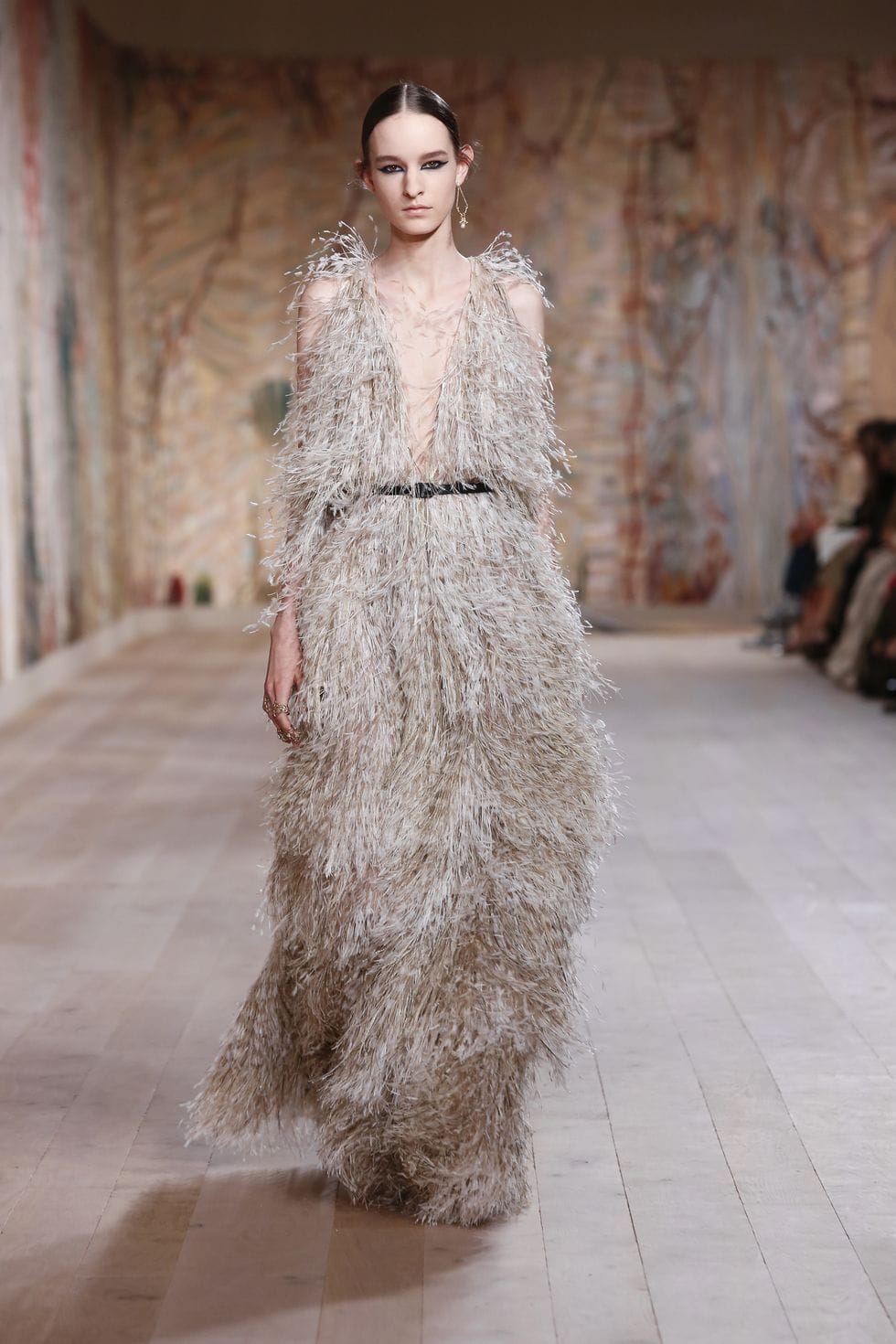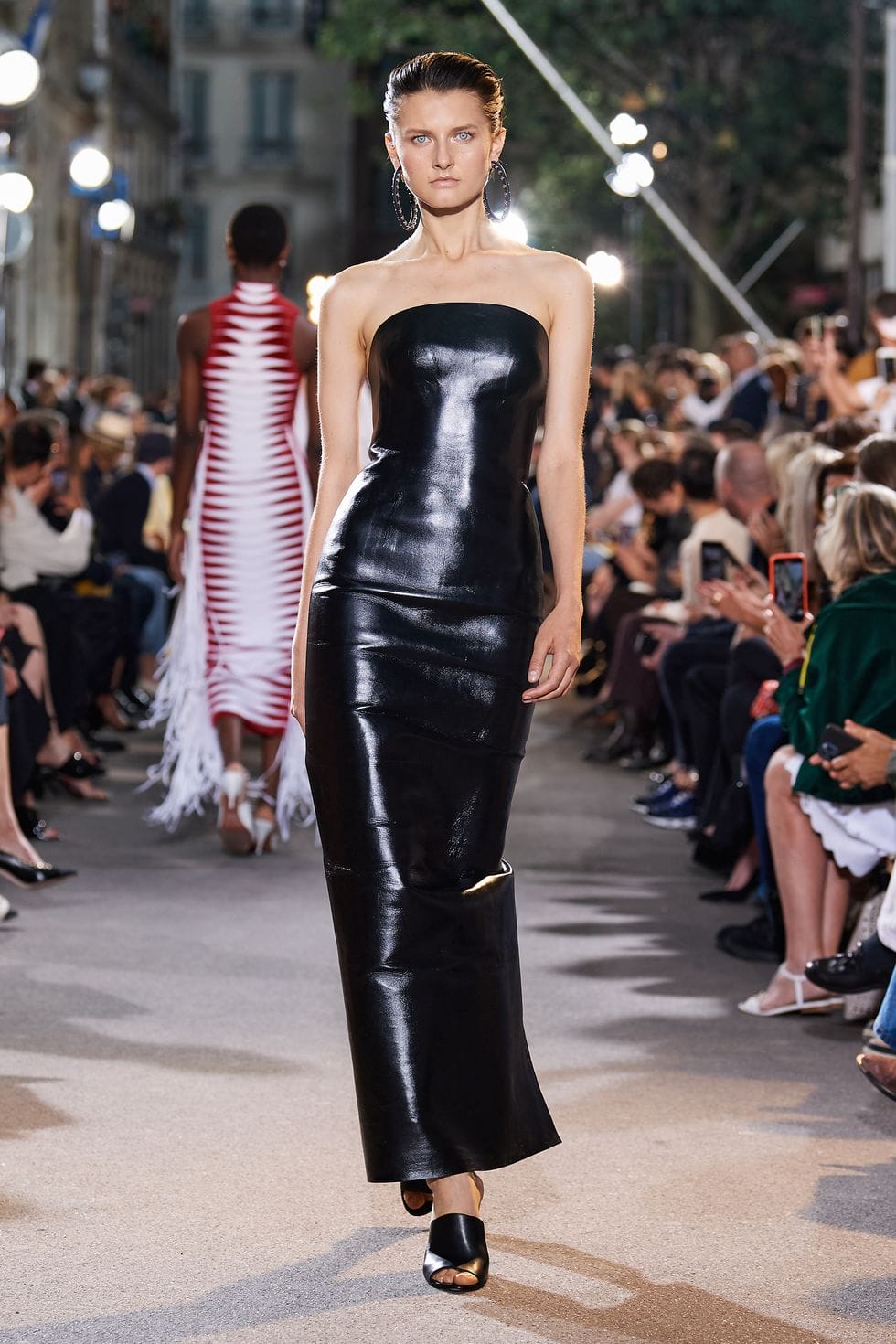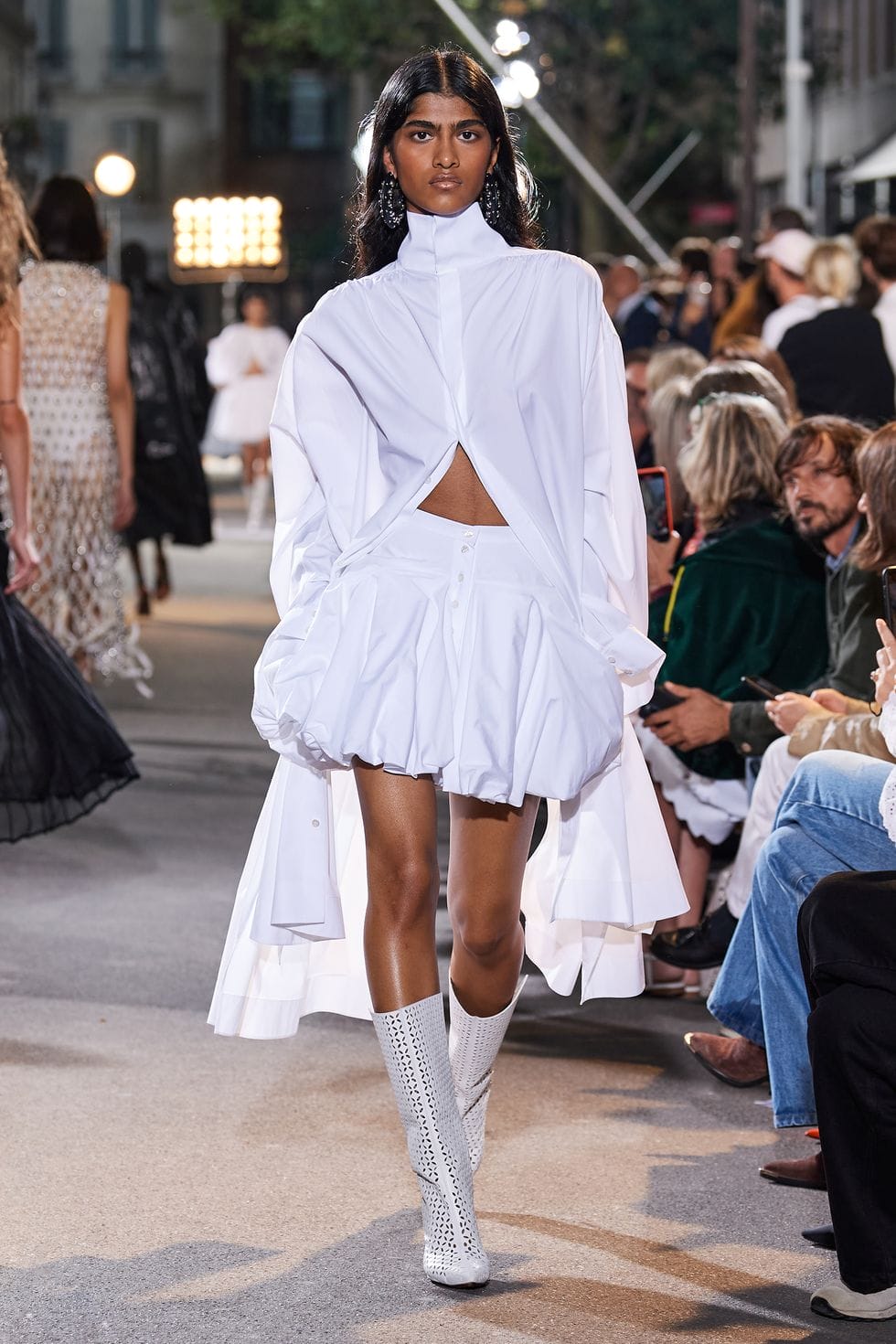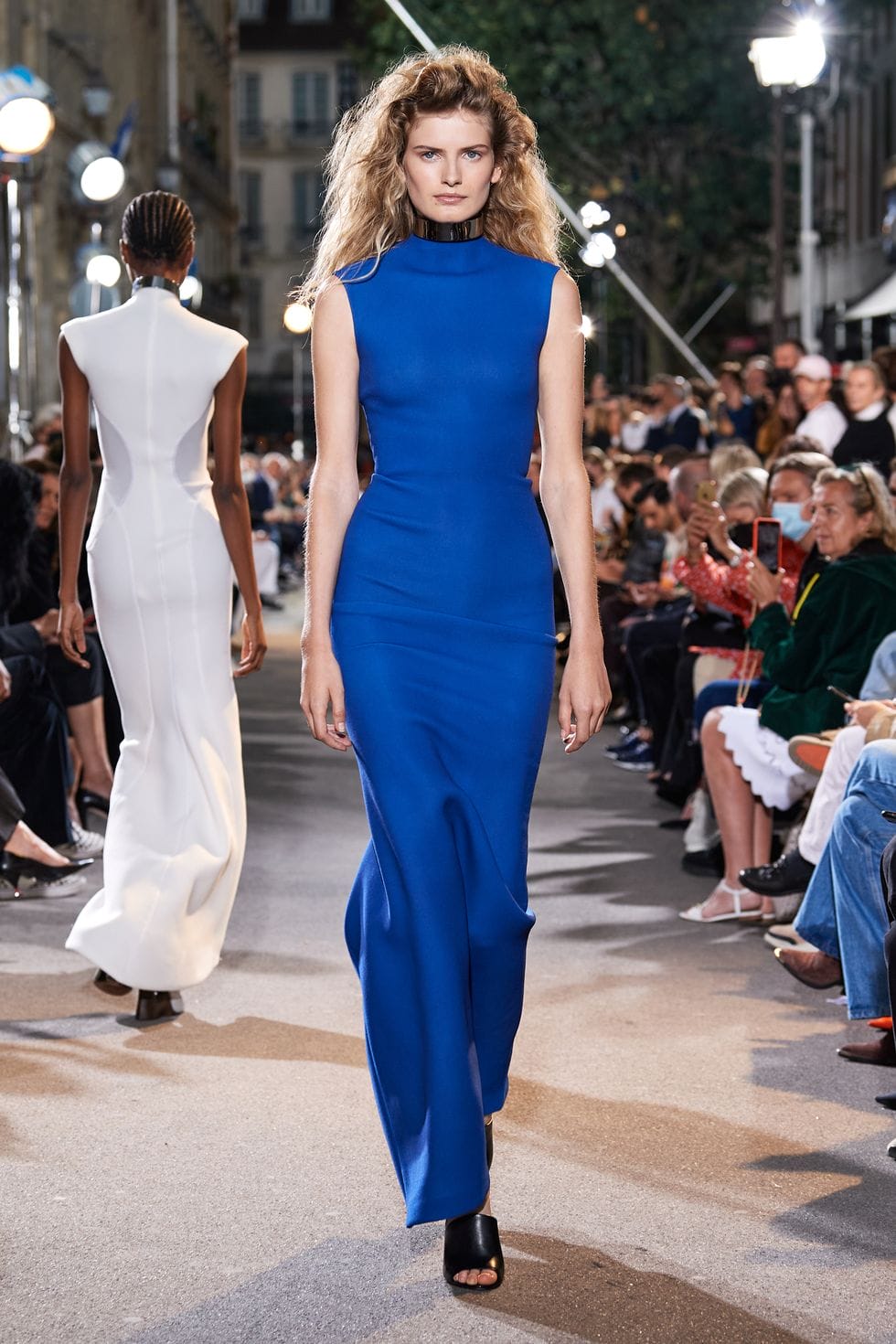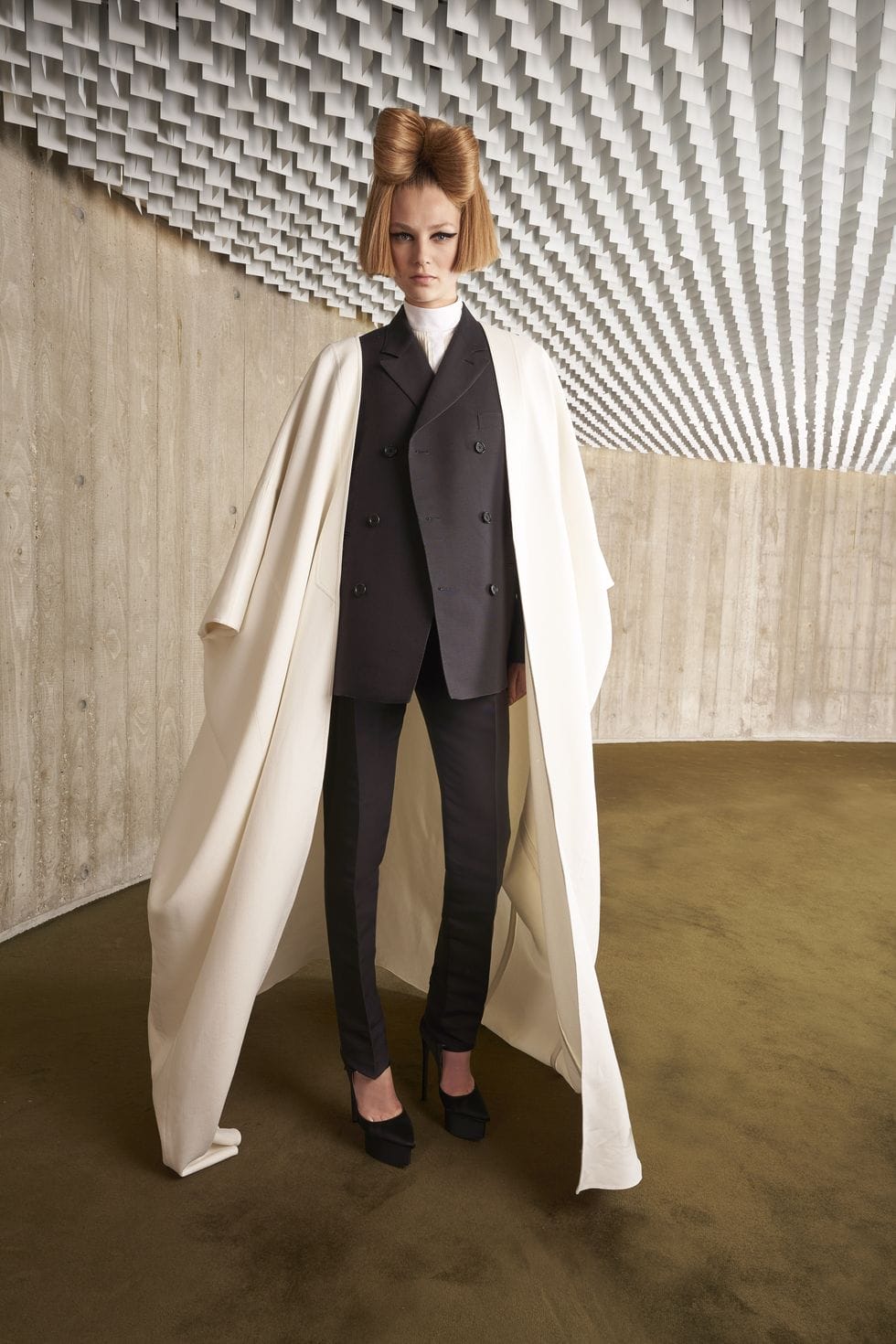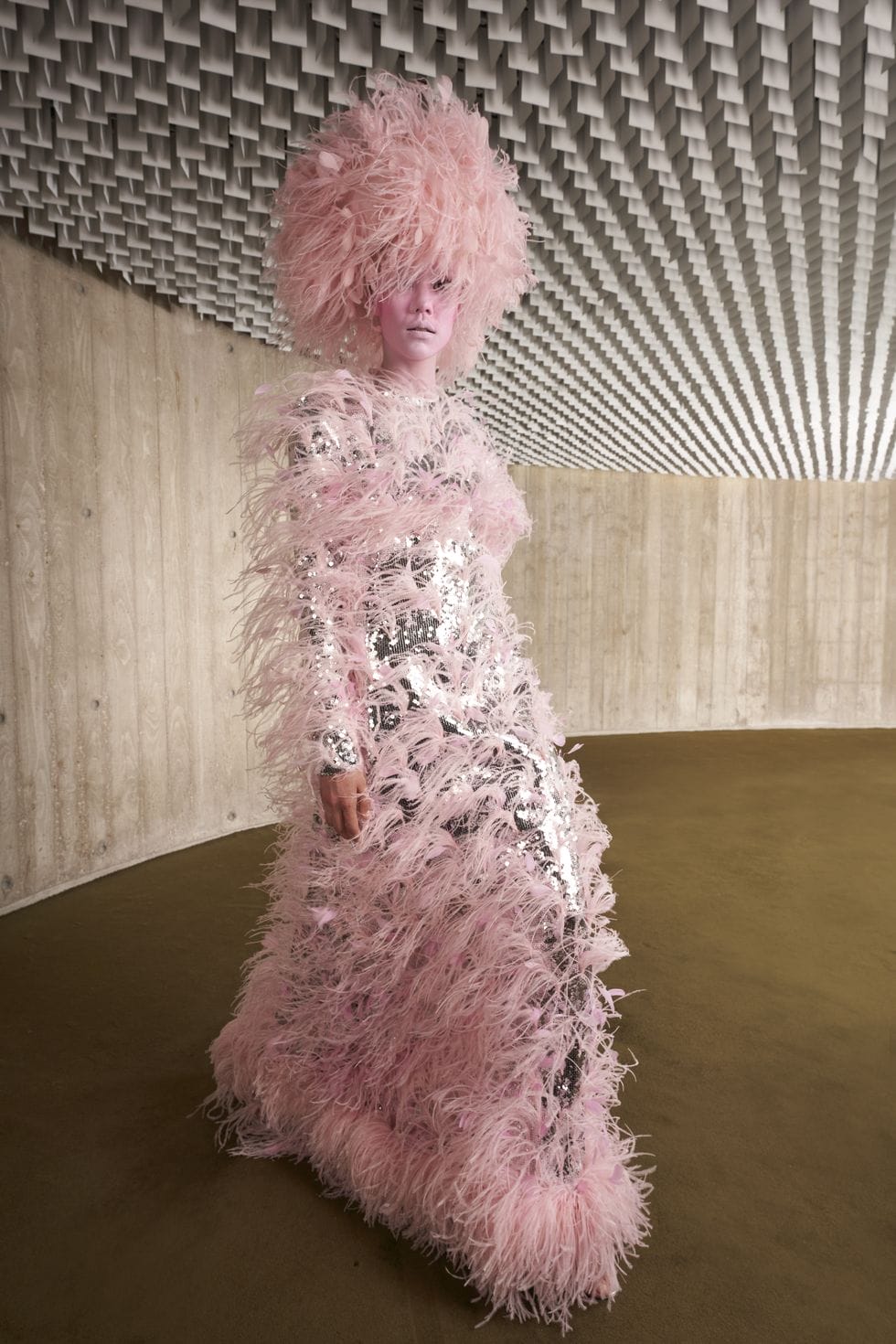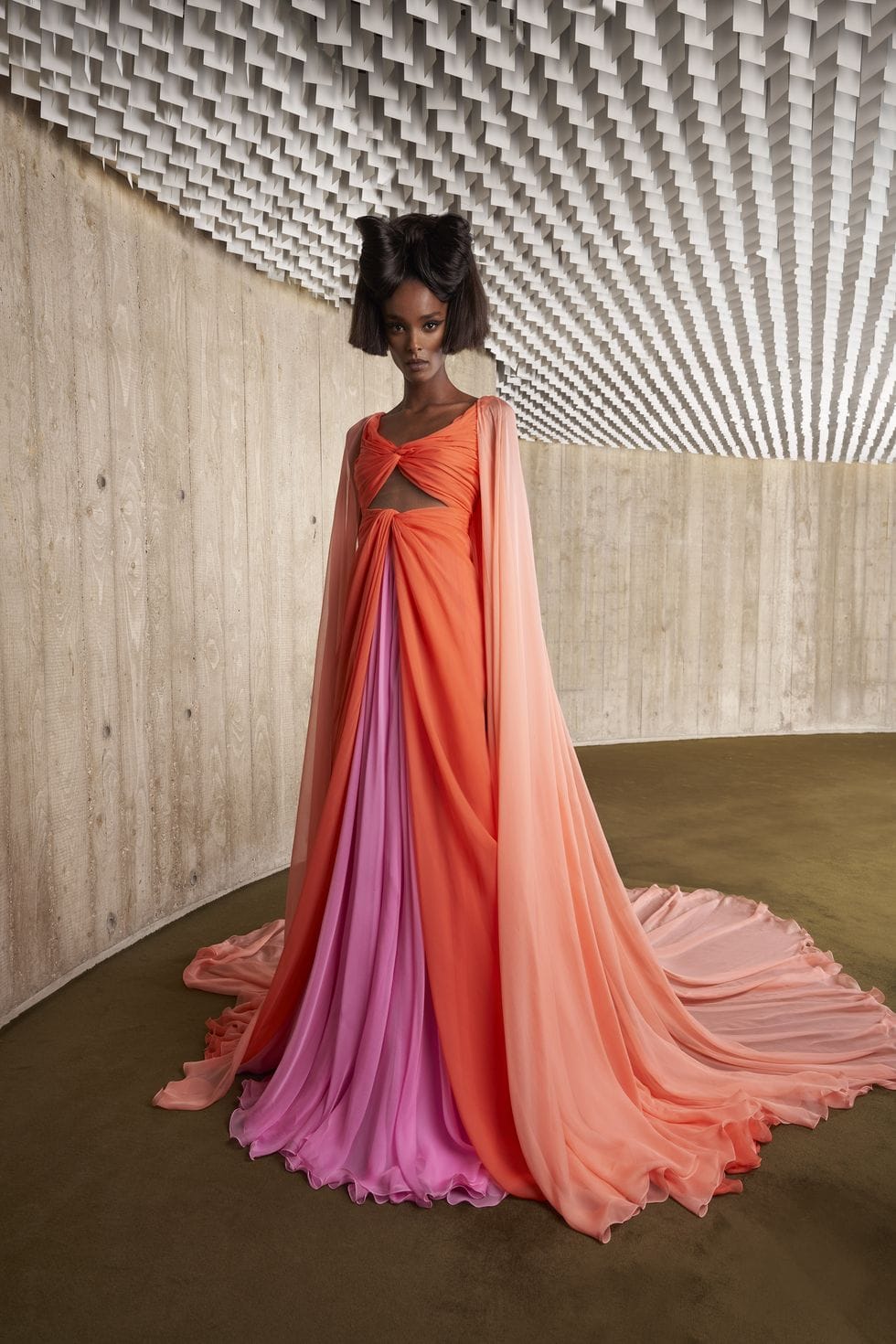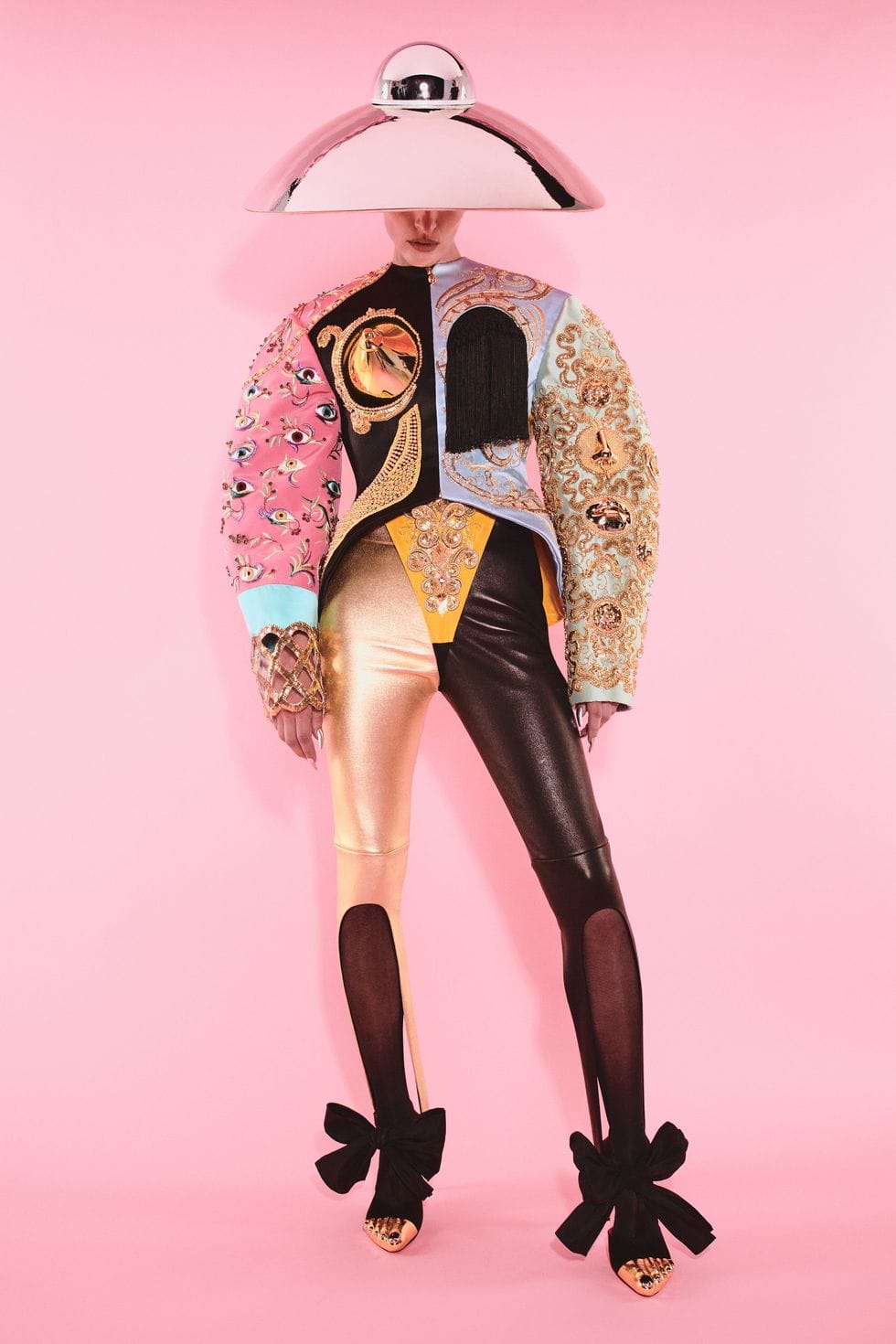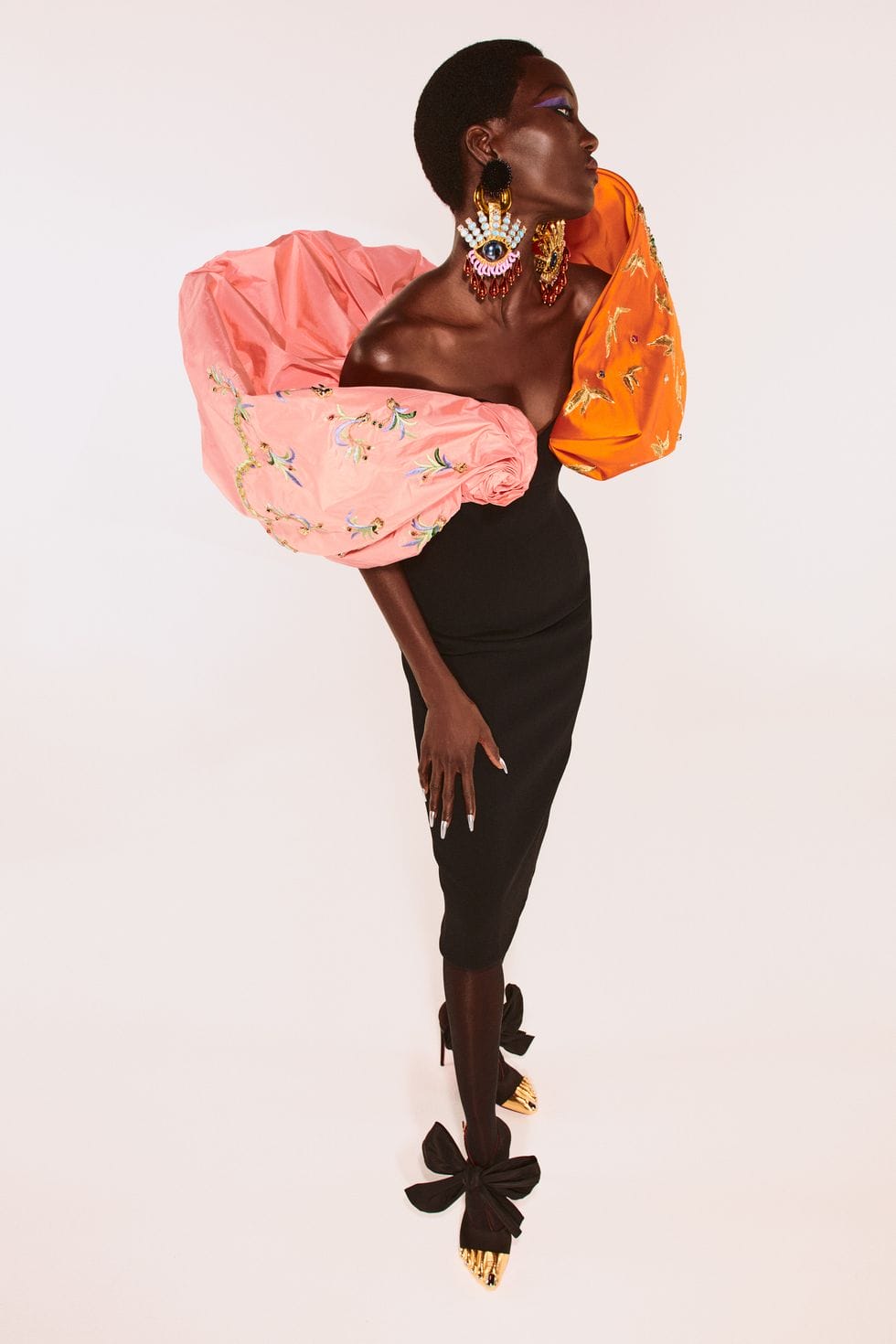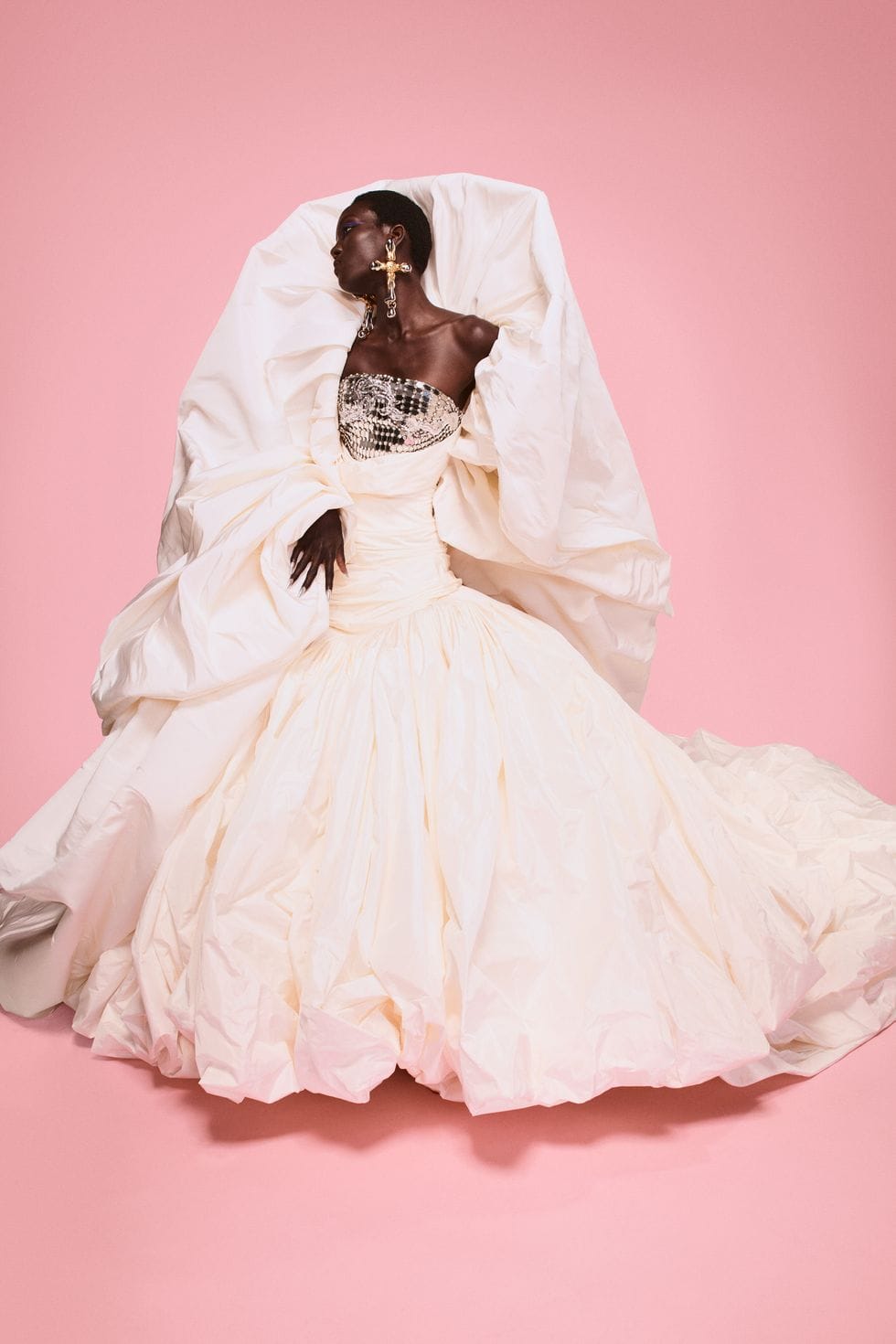Je t’aime.
Words by Kerry Pieri, Carrie Goldberg, Alison S. Cohn and Leah Melby Clinton
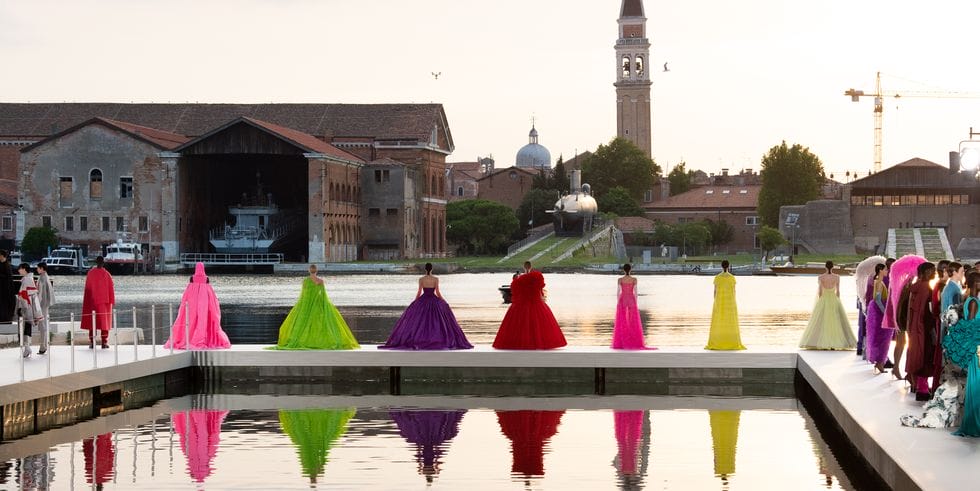
Pietro D’Aprano
Haute couture is fully in person again, and how we have missed those magical moments on the runway. See the best looks from the biggest houses, created by masters of their craft—straight from Paris.
Valentino
Courtesy of Valentino
“Fashion is not ‘art,’” Valentino creative director Pierpaolo Piccioli wrote in the notes accompanying his Valentino Des Ateliers show. But one might beg to differ after witnessing his bravura performance today at the Arsenale, home of the Venice Biennale. Together with curator Gianluigi Ricuperati, Piccioli assembled a dream team of 16 international contemporary artists as collaborators. The collection was called “Des Ateliers” (Of Ateliers) to signify that the ateliers—the artists’ and Valentino’s—worked together to design and fabricate some of the pieces. The results were sculptural and featured grandiose ball gowns, balloon jackets, and bubble hem minidresses underneath giant trembling ostrich frond hats by master milliner Philip Treacy, all awash in vibrant color. —Alison S. Cohn
Pyer Moss
DAVID X PRUTTING/BFA.COM
Pyer Moss shows shine a light on the often over-looked role of Black people in shaping American history. For his couture debut, livestreamed from the Madam C.J. Walker estate in Irvington, New York as the final show of Paris couture, creative director Kerby Jean-Raymond turned his attention to Black inventors. Each of the 25 looks took cues from Black inventions such as the horseshoe (Oscar E. Brown), a giant replica of which was held aloft by a model in an ice blue pannier-hipped cutout gown. A fascinator in the shape of a lock (W.A. Martin) topped a gold paillette-encrusted minidress, while a white double-breasted suit with cascading ruffles of “paper” represented the typewriter (Lee S. Burridge and Newman R. Marshman). —Alison S. Cohn
Maison Margiela
Courtesy of Maison Margiela
At its most dramatic, fashion fuels escapism and allows for mysticism. That fantastical landscape isn’t a space where all designers are comfortable playing, but it’s the stock-in-trade for others. John Galliano has always felt most at home outfitting characters, and his latest work for Maison Margiela is no different. This “Artisanal” collection is inspired by “a new utopian youth connected to the circles of life, time and nature,” or, in other words, the sort who haunt thrift markets searching for items imbued with history and a patina from past lives. He’s reimagined iconic elements and silhouettes like quilting, corsetry, and fisherman’s knits via a new Maison Margiela technique: “Essorage” turns vintage and deadstock fabric into something new-but-old through stonewashing and enzyme treatments, resulting in pieces that look like they were plucked from a centuries-old painting. The combination creates character on top of character, ensuring that Galliano’s just-crafted designs feel the opposite of sterile. It’s fashion for modern raconteurs and bards who never underestimate the ability of clothing to contribute to the narrative. —Leah Melby Clinton
Fendi
Courtesy
Kim Jones debuted his first Haute Couture collection for Fendi last season, which “traced his transition from England to [Italy]” via a study of literature references and romance. The designer continued that dreamy yet dramatic thread this season as well—but this time, in his new home base of Rome. Inspired by the lens Roman film director Pier Paolo Pasolini used to view the Eternal City, Jones broke down its architecture, textures, poetry, and grandeur in swaths of trompe l’oeil marble silks, frothy feather gowns, and embroideries that appeared to mimic the dynamic nature of frescoed ceilings. The accessories also played a starring role, as did the slew of all-star supermodels that graced the couture catwalk, from Kate Moss to Christy Turlington. The colosseum’s archways were featured as heels—both as pumps and thigh-high boots—and inspired the structure for the show’s stunning set. Also breathtaking were Jones’ haute couture versions of the baguette, which were bijoux in their own right. —Carrie Goldberg
Jean Paul Gaultier
Courtesy of Jean Paul Gaultier
If it ain’t broke, you might not necessarily fix it, but you can retool, rethink it, and overall fool with it. As the guest designer brought on board to interpret the codes of the house through their own lens—a different talent will be featured every season—Sacai’s Chitose Abe lined up a who’s who (what’s what?) of the classics and put a couturier’s spin on them. Suiting, shirting, Breton stripes, and denim all got the experiential treatment, and the results were breathtaking. It’s fashion you want to both think about and wear: pieces that score high on the drama and glamour while also making you question what a silhouette means. Are blue jeans workday utilitarian when sculpted as a smart jacket and expansive skirt? Is a button-up the epitome of white-collar professionalism when it’s romantically oversized and floats behind the body? Fashion’s meant to make us think and imagine new possibilities, two charges that Jean Paul Gaultier always scores high on. —Leah Melby Clinton
Viktor&Rolf
Courtesy of Viktor&Rolf
Viktor Horsting and Rolf Snoeren outfitted the royals this go-around (and by royals, we mean the regal sort who walk among us: couture clients). The duo believes we can all dress and behave like the most upper of upper crusts, and the beauty queen sashes accompanying each look toss out quippy bon mots worthy of a guidance counselor’s office. The graphic touch isn’t one actually spotted on the Buckingham Palace balcony, but speaks to their inspiration of modern royals putting a human touch behind the historic pomp and circumstance. Meanwhile, the dresses and coats maximize the type of richness monarchical fashion has always favored with paste gemstones that would barely fit into the palm of your hand, heavy brocades, and dramatic coats that require a chauffeured backseat position. It would certainly be fun to see it all make an appearance at some formal state dinner, but don’t get your hopes up. Fashion this loud is far too bold for an institution still focused on subtle signaling. —Leah Melby Clinton
Balenciaga
Courtesy
Six years into his tenure at Balenciaga, Demna Gvasalia debuted his first couture collection for the storied French house. Haute couture cannot be rushed, after all. It was worth the wait. The designer wrote a letter to accompany the 63 looks. In it, he mentions that Mr. Balenciaga shuttered his doors 50 years ago, mostly due to the rise in ready-to-wear. Consider this a full-circle moment, then, for the century-old brand. In a rather pragmatic note, Gvasalia wrote, “The relaunch of the Couture line will offer the highest creative and qualitative level of product to our customer, as well as complete my multi-layered vision for Balenciaga the brand, which ranges all the way up from streetwear into conceptual fashion and wardrobe and ultimately into one-of-a-kind, made-to-measure couture pieces.”
Those pieces ranged from double-breasted black suiting to tweedy dresses paired with oversized hats that felt like a direct nod to Cristóbal, polka-dot separates, sequined gowns, a killer off-the-shoulder trench coat, and voluminous green and pink taffeta floor-length dresses. An embroidered off-the-shoulder dress styled over trousers looked as though it could have been worn by Audrey Hepburn herself. The designer continued in his notes, “Couture is a timeless and pure expression of craft and the architecture of silhouette that gives the wearer the strongest notion of elegance and sophistication.” This collection, indeed, feels like it will withstand the test of time. —Kerry Pieri
Armani Privé
Courtesy of Armani Privé
Sometimes you want to be surprised, and other times you want the exact opposite: to be presented with something expected and reliable, a known entity. Such is the case with Armani Privé, two words that convey a signature aesthetic that never wavers from season to season. It’s couture as comfort and feels even more soothing after the tumult of recent. This collection, to no surprise, is made up of decade-proof silhouettes and expert tailoring that whispers rather than shouts. Silk organza is, as ever, used to masterful effect, looking like molten metal that was poured onto the figure. Couture by definition is crafted to impress at the cellular level, yet the long-established magic of Armani Privé demands movement. From liquid-like organza trousers to cloudlike ball gowns, the creations floating down the runway are exactly what was expected (thank goodness). —Leah Melby Clinton
Chanel
Courtesy of Chanel
Virginie Viard’s fall couture heroines looked like the protagonist of Portrait of a Lady, and were inspired, the designer said in her show notes, by the works of several of her favorite 19th- and early 20th-century French painters including Berthe Morisot, Édouard Manet, and Marie Laurencin. “I was also thinking about English gardens,” she explained. “I like to mix a touch of England with a very French style. It’s like blending the masculine and the feminine, which is what I’ve done with this collection too.” Many of the standout pieces had an Impressionistic quality, such as a sequined tweed jacket and an A-line skirt that seemed made up of a multitude of paint strokes, and a tulle dress embroidered with water lilies that brought Claude Monet’s most famous series of oil paintings to mind. Others, like a fuchsia suit with fluid ruffles and a black paletot jacket embellished with pink and yellow tulle pom-poms, had a bold, more graphic quality. —Alison S. Cohn
Alexandre Vauthier
COURTESY OF ALEXANDRE VAUTHIER
A wide open space where drama, danger, and dreams mix, the western frontier always inspires. Its iconic silhouettes and caricatures have long bled into fashion. Add a healthy dose of rock-and-roll glamour and you have the ingredients that coalesced for Alexandre Vauthier’s latest. Leathery fringe, dramatic plumes, studded brads, and diamante were used to outfit the saloon girl who’s with the band. There was a lot—strips of leather dusted the floor, and embellishments threw light on par with the glitziest disco ball—but Vauthier was always controlled with strict tailoring and the briefest of hemlines. Full-on maximalism would have been too one note; instead, we were treated to a finely worked study of contradictions. —Leah Melby Clinton
Dior
Courtesy
Dior is back on the runway—and it’s safe to say that we’re all cool on fashion films for the moment. Maria Grazia Chiuri’s Haute Couture offering, shown against a hand-embroidered landscape by artist Eva Jospin and inspired by the walls of the Indian Embroidery Room at the Palazzo Colonna in Italy, leans into texture. The tweeds send a tactile message that these are pieces to not only be seen in, but also to touch. The theme of the collection, “being present,” references a higher Buddhist-level awareness, but also the simple act of togetherness. Clare Hunter’s book Threads of Life, with its emphasis on the importance of the time-honored traditions of weaving and embroidery and the people adept at it, also played a large role in Chiuri’s designs. In a palette of mostly black and white with hints of blues and greens, delicate gowns fluttered off the body, while wrap coats enveloped the models—all created by masters of their craft, women and men Chiuri is aware are all part of the delicate economic balance that unites us. The utter beauty of intricately created fashion can serve as a reminder of the interconnectedness of us all, not unlike a coat woven together expertly. —Kerry Pieri
Alaïa
A Belgian designer who cut his teeth as Raf Simons’s right hand at Jil Sander, Dior, and Calvin Klein, Pieter Mulier wanted his first collection for the house that literally defined body-con dressing to be “a return to foundations.” There was a roll call of founder Azzedine Alaïa’s greatest hits including body-sculpting knitwear, multi-strap corset belts, and hooded silhouettes evocative of Alaïa’s North African roots. But this was no mere archive dive. Mulier transfigured Alaïa staples like the white poplin shirt, which was an underpinning for the founder’s showstopping corset belts. In Mulier’s interpretation, the shirt itself took center stage via an ingenious series of flowing tops cut away to reveal a triangle of solar plexus sure to make Dua Lipa or Doja Cat happy. These were paired with bubble-hem maxi skirts or kicky pleated minis for maximum #legs. —Alison S. Cohn
Giambattista Valli
Courtesy
Words like drama, volume, and regal come to mind when envisioning Giambattista Valli’s couture confections. A Valli girl tends to be fairly straightforward in her flair for grandeur, epic volumes; bold colors; and otherworldly proportions. But this season, tuxedos and capes are also part of her wardrobe—and his. A number of menswear looks join the Valli ranks this season as a nod to the spontaneity of a late night spent in Paris, a provocative “ride that will end with an exchange of clothes and the line between day and night fading away.” Valli notes Ryan Murphy’s dark side and Paris’s provocative and alluring nightlife as key sources of inspiration. And now that we’ve emerged from lockdown and Paris is “burning with its new vitality,” the season is painting a picture of how the best parties will go, with what was once branded as a misogynistic “walk of shame” transforming into a chic couture outfit swap. —Carrie Goldberg
Schiaparelli
Courtesy
Going back in time isn’t Daniel Roseberry’s thing; he’s not looking to create a shrine to Elsa Schiaparelli. Instead, he’s envisioning what the future of this historic brand will be by reexamining what it means to be feminine, pretty, and powerful. “Blind nostalgia isn’t healthy: We can’t romanticize the past, especially when, for so many groups of people, the past wasn’t romantic at all,” Roseberry says in his thoughtful and thought-provoking show notes. The creative director breaks his collection down into parts: a tribute to Schiaparelli’s iconic matador-cut jackets, a continuation of the body as bijoux, and the use of jewelry to create a portion of a silhouette, and a deep dive into color. The collection dreams big; it is expansive, touches on much of the brand’s history and DNA, but it is equally forward thinking, capping off with a bridal gown that is more of a focal point in the collection’s themes rather than a traditional haute couture finale. Roseberry is off to a marathon start in shedding the need for nostalgia and looking toward fashion’s future. His dreams include, “No more cookie-cutter fashion. No more pieces that look like they could have been made by anyone. No more cynicism. No more irony. No more timidity. No more coolness. Give me more beauty, more earnestness, more romance, more effort. … Give me more hope.” And he delivers all in spades.
– – – – –
This article originally appeared on harpersbazaar.com


